
 La Brea Tar Pits fauna as depicted by Charles R. Knight
La Brea Tar Pits fauna as depicted by Charles R. Knight
A list of prehistoric and extinct species whose fossils have been found in the La Brea Tar Pits, located in present-day Hancock Park, a city park on the Miracle Mile section of the Mid-Wilshire district in Los Angeles, California.
Some of the tar pit's fossils are displayed in the adjacent George C. Page Museum of La Brea Discoveries in the park. They are primarily from Pleistocene predator species. Daggers (†) in the list denote extinct species.
Mammals
Artiodactyla
| Common name | Species | Material | Notes | Image |
|---|---|---|---|---|
| † Western camel | † Camelops hesternus | at least 36 individuals. | A large species of camel with a generalized browsing diet. Camelops, alongside the ancient bison and the western horse, is one of the most common large herbivores found in the tar pits. |  |
| † Ancient bison | † Bison antiquus | At least 300 individuals. | A large migratory bison species, possibly ancestral to the modern American bison through the intermediate Bison occidentalis. It is the most common large herbivore found at La Brea. |  |
| † Dwarf pronghorn | † Capromeryx minor | Hundreds of specimens. | A diminutive pronghorn less than half the size of the modern species. Due to the decreased weight and size, Capromeryx was generally more slender than other pronghorns. It further differs through its conical, non-branching horns. Although most of the skeleton was known by 1914, it wouldn't be until over a hundred years later that the postcranial bones would be described in detail. |  |
| † Flat-headed Peccary | † Platygonus compressus | A fragmentary skull and limb bones | A widespread species of peccary known to have inhabitet grassland and arid regions. Compared to other species of its genus, Platygonus compressus was better adapted at feeding on grasses. |  |
| † Giant bison | † Bison latifrons | One of the largest known ruminants, the long-horned bison is thought to be the direct ancestor to the ancient bison. Bison latifrons differs from the other La Brea species in size and the dimensions of the horns. |  | |
| Cf. Mule deer | Odocoileus cf. hemionus | Deer remains that were tentatively assigned to the modern mule deer by several authors. However, in Balassa et al. 2022 these remains are assigned to the white-tailed deer instead. |  | |
| Pronghorn | Antilocapra americana | An extant relative of the dwarf pronghorn Capromeryx, this species is notably larger and features characteristic two-pronged horns. The La Brea material is indistinguishable from the modern form. | 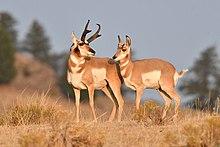 | |
| Cf. Wapiti | Cervus cf. canadensis | Although present at the tar pits, material assigned to the modern elk has not been dated. This leaves it ambiguous whether or not it coexisted with some of the well known La Brea animals such as the short-faced bear and American lion. |  | |
| † Shrub-ox | † Euceratherium cf. collinum | An extinct relative of the modern muskox. Findings from Colorado suggest that it was a browser that fed on trees and shrubs. | 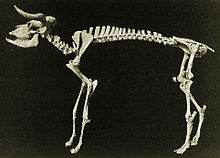 | |
| † Large-headed llama | † Hemiauchenia macrocephala | Isolated Limb Bones | A species of llama with an opportunistic generalized diet. |  |
Carnivora
| Common name | Species | Material | Notes | Image |
|---|---|---|---|---|
| American badger | Taxidea taxus | Badger fossils make up approximately 0.39% of the total carnivoran fauna at Rancho La Brea. It is possible that some of the badgers may have become trapped when tar entered their burrows. |  | |
| American black bear | Ursus americanus | Among the black bear remains from La Brea is the skull of a juvenile individual. Black bears from this time were larger than their modern relatives, but are relatively underrepresented in the La Brea fossil record. This might be due to their omnivorous diet, suggesting that the abundance of predators may be directly related to scavenging behavior. |  | |
| † American cheetah | Miracinonyx trumani | Isolated remains | A 2022 study has argued that multiple isolated remains, including a humerus, a radius, a femur and the holotype mandible of Felis daggetti, which at times were referred to the modern cougar, actually represent Miracinonyx trumani. | |
| † American lion | † Panthera atrox | At least 80 individuals | A large pantherine, the American lion is a possible descendent of Eurasian cave lions that had become isolated in North America. This big cat is found much more rarely than the contemporary Smilodon. Within the species itself, more fossil specimens are thought to represent males. | 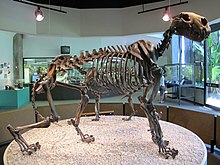 |
| Bobcat | Lynx rufus | Bobcats are rare compared to other cats at La Brea. Van Valkenburgh suggests that they may have lived at the fringe of the predator community. |  | |
| Cougar | Puma concolor | Isotopic analysis suggests that cougars, as well as other large cats at La Brea, preferred to hunt prey living in more closed environments. Cougars were found to be more generalized in diet than contemporary cats such as Smilodon or the American lion, which could be the reason why they survived into modern days. |  | |
| † Dire wolf | † Aenocyon dirus | Over 4.000 individuals | A large wolf-like carnivore, the dire wolf was the most common predator found in the tar pits of La Brea, outnumbering the slightly smaller grey wolf over 100-fold. They could reach a weight of approximately 68 kg (150 lb). Despite the name this animal is not a wolf but instead part of its own genus distinct from Canis that evolved independently from modern wolves. |  |
| Domestic dog | Canis familiaris | Several individuals | The dogs from La Brea include a small dog similar to the Techichi breed. Despite being found close to the human remains known as the La Brea Woman, the dog remains proved to by approximately 7.000 years younger. This means that there is no connection between the dog and human remains of La Brea. Another larger individual was initially thought to be a distinct species. | |
| † Giant jaguar | † Panthera onca augusta | At least five individuals represented by 20 specimens, which include a palette, vertebrae, ribs and limb bones | A giant subspecies of the modern jaguar. The material ranges in age from 11,600 years to 28,000 years old. |  |
| † Giant short-faced bear | † Arctodus simus | At least 30 individuals | Arctodus was one of the largest known carnivorans in history and belonged to the Tremarctinae, a subfamily of bears endemic to the Americas. Studies suggest that much like many modern bears, Arctodus was an omnivore with no direct adaptations for either hypercarnivory or scavenging as previously believed. This bear reached an average weight of 600 kg (1,300 lb). |  |
| Gray fox | Urocyon cinereoargenteus | Remains of gray foxes make up 0.48% of the La Brea predator fauna. A baculum from the pits suggests that these foxes were smaller in the past. |  | |
| Gray wolf | Canis lupus | Modern wolves are notably rarer at La Brea than the slightly larger dire wolves. One particular fossil preserves the femur of a wolf that survived a traumatic injury. The nature of the fossil suggests that the wolf's leg was either broken and developed a pseudarthrosis or that the leg was entirely amputated and healed. Such an injury could have been inflicted by the numerous larger predators such as bears, big cats or dire wolves. | 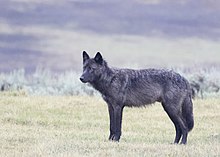 | |
| Grizzly bear | Ursus arctos horribilis | A complete grizzly bear skull was found in Pit 10, which also yielded human remains. Carbon dating confirms that the Californian grizzly only appeared in La Brea after the extinction of the larger short-faced bear. |  | |
| Long-tailed weasel | Neogale frenata | 53 skulls | Isotopic analysis indicates that at La Brea the long-tailed weasel fed on ground squirrels and cottontail rabbits. It is the most common mustelid at La Brea. |  |
| † Pleistocene coyote | † Canis latrans orcutti | Fossils from La Brea show that Pleistocene coyotes were larger and more robust than their modern relatives and actively hunted larger prey. However, Holocene coyote fossils from Pit 10 already show a decrease in size and change in the anatomy of the mandible, indicating that by this point in time coyotes had begun adapting towards conditions more similar to today. This includes changing their diet from large prey to smaller animals such as rabbits. They are the third most common predator found in the tar pits, only behind the dire wolf and Smilodon. |  | |
| Raccoon | Procyon lotor | A single specimen | Raccoons and the related ringtail may be rare due to their nocturnal habits, which would mean they are active when the tar is cool and more solid. |  |
| Ringtail | Bassariscus astutus | A single specimen |  | |
| † Saber-toothed cat | † Smilodon fatalis | Over 2.000 individuals represented by more than 130.000 specimens. | Smilodon is among the most well-known mammals from Rancho La Brea and the second most common carnivore found in the pits, only behind the dire wolf. Unlike the American lion, which is a true cat, Smilodon was a member of the Machairodontinae. Based on the microwear texture of the teeth it has been suggested that Smilodon fed on both harder material and soft flesh, preferring the later following injuries to the jaws and teeth. |  |
| † Scimitar-toothed cat | † Homotherium serum | Canine teeth and metapodials | Relative to the related Smilodon, Homotherium was much rarer at La Brea. Ecologically it was a more cursorial hunter preferring open environments and predominantly feeding on grazers. Among the prey known to have been taken by Homotherium are juvenile mammoths. | 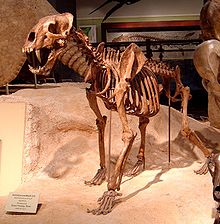 |
| Striped skunk | Mephitis mephitis | Approximately 0.96% of the La Brea carnivore fauna is made up of striped skunks. |  | |
| Western spotted skunk | Spilogale gracilis | Fossils of the spotted skunk are rarer than those of striped skunks. They only account for 0.18% of La Brea's carnivoran fauna. |  |
Chiroptera
| Common name | Species | Material | Notes | Image |
|---|---|---|---|---|
| Hoary bat | Lasiurus cinereus | Remains of the hoary bat were discovered in Pit 91. | 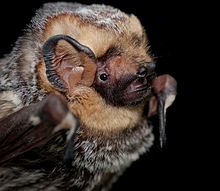 | |
| Pallid bat | Antrozous pallidus | Pallid bats might have become entrapped in tar due to their habit of feeding on insects near the ground. |  |
Lagomorpha
| Common name | Species | Material | Notes | Image |
|---|---|---|---|---|
| Black-tailed jackrabbit | Lepus californicus | This species appears to only occur in deposits from the Last Glacial Maximum onward and is absent in those predating it. This could be indicative of environmental changes occurring at La Brea in this time period. |  | |
| Brush rabbit | Sylvilagus bachmani | The brush rabbit is more commonly found in the older La Brea deposits. This might be because the species requires denser vegetation and was faced with increased aridification and more open environments that favored jackrabbits and desert cottontails. | 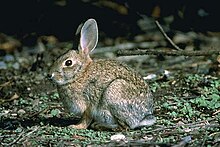 | |
| Desert cottontail | Sylvilagus audubonii | Excluding juvenile remains, desert cottontail fossils from La Brea suggest that the species was smaller than modern individuals |  |
Perissodactyla
| Common name | Species | Material | Notes | Image |
|---|---|---|---|---|
| † California tapir | † Tapirus californicus | One jaw with teeth and two phalanges | A small species of tapir known from few remains at La Brea. The taxonomic status of many North American tapirs is debated and many of the species may be synonyms of each other. | |
| † Mexican horse | † Equus conversidens | A small bodied horse species of dubious nature, only few remains are known from La Brea. Some researchers have argued that the Mexican horse is a synonym of Haringtonhippus or that the name is a nomen dubium. |  | |
| † Western horse | † Equus occidentalis | Over 200 individuals | One of the most common herbivores found in the tar pits, its teeth are more complex than that of modern horses. Due to this the western horse has been interpreted to have filled a different dietary niche than horses today, possibly being a mixed feeder consuming a not insignificant amount of wooden browse from shrubs and other plants. |  |
Primates
| Common name | Species | Material | Notes | Image |
|---|---|---|---|---|
| Human | Homo sapiens | A skull and partial skeleton commonly known as the La Brea Woman. | The remains of a woman between 18 and 24 years old who died of a fractured skull. This skeleton represents the only known human remains from the tar pits. She was found alongside a grinding stone and may have been buried in the tar. | 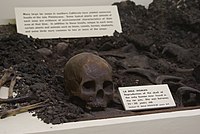 |
Proboscidea
| Common name | Species | Material | Notes | Image |
|---|---|---|---|---|
| † Columbian mammoth | † Mammuthus columbi | At least 36 individuals. | A large species of mammoth. The largest individual found at La Brea, nicknamed Zed, was unearthed in 2006 and had tusks 3.16 m (10.4 ft) long (measured along their outer curve). Zed is also the most complete mammoth found in the tar pits, preserving 80% of the bones. |  |
| † Pacific mastodon | † Mammut pacificus | 11 specimens. | The Pacific mastodon is endemic to the western United States including California and Idaho. This species differs from the American mastodon by having narrower teeth and lacking mandibular tusks. Additionally, this species has 6 instead of 5 neck vertebrae and a more robust femur. |  |
Rodentia
| Common name | Species | Material | Notes | Image |
|---|---|---|---|---|
| Agile kangaroo rat | Dipodomys agilis | A relatively common rodent. | ||
| Botta's pocket gopher | Thomomys bottae | Gopher skulls are said to be abundant from La Brea. Joseph Grinnell describes these skulls to be identical to those of modern Botta's pocket gophers, which still inhabit California today. |  | |
| California ground squirrel | Otospermophilus beecheyi |  | ||
| California pocket mouse | Perognathus californicus | A relatively abundant species. |  | |
| California vole | Microtus californicus |  | ||
| Dusky-footed woodrat ? | Neotoma fuscipes ? | Hundreds, possibly thousands of fossil fecal pellets (coprolites) are known from La Brea and assigned to Neotoma in addition to fossil bones. While the bones have historically been identified as Neotoma fuscipes, taxonomic revisions have cast doubt on the assignment. Today Neotoma lepida and Neotoma macrotis are still found in the area, the later of which was formerly considered to be a subspecies of Neotoma fuscipes. The La Brea fossils could subsequently represent one of these two species, a southern population of N. fuscipes or even a hybrid. |  | |
| † Imperfect mouse | † Peromyscus imperfectus | The only extinct rodent from La Brea. This species may be ancestral to the deer mice of the south Californian islands. | ||
| Merriam's chipmunk | Neotamias cf. merriami |  | ||
| Southern grasshopper mouse | Onychomys torridus |  | ||
| Western harvest mouse | Reithrodontomys megalotis |  |
Soricomorpha
| Common name | Species | Material | Notes | Image |
|---|---|---|---|---|
| Broad-footed mole | Scapanus sp. | A single right humerus | The remains of the broad-footed mole have been found at Pit 91. | 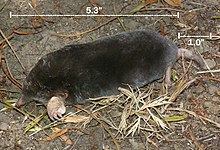 |
| Crawford's gray shrew | Notiosorex crawfordi | This species is notably more common in the tar pits than the ornate shrew, outnumbering the later 10:1. |  | |
| Ornate shrew | Sorex ornatus | A few bones | The ornate shrew is still found at La Brea today. |  |
Xenarthra
| Common name | Species | Material | Notes | Image |
|---|---|---|---|---|
| † Harlan's ground sloth | † Paramylodon harlani | Over 70 individuals with at least 30 preserved skulls. | The largest and most common of the La Brea sloths. Harlan's ground sloth is considered to be a "grazing sloth" with large portions of its diet being composed of grasses. Coltrain and colleagues however argue that it was more of a mixed feeder regardless of the dental anatomy. |  |
| † Jefferson's ground sloth | † Megalonyx jeffersonii | Megalonyx appears to be the rarest of the three La Brea ground sloths. Although more closely related to Nothrotheriops, it approached Paramylodon in size. It was a browsing animal preferring woodland and forest. | 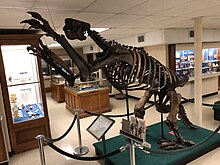 | |
| † Shasta ground sloth | † Nothrotheriops shastensis | A solitary ground sloth species roughly the size of a bear. Unlike Paramylodon it was a browser that may have only occasionally come into proximity of the tar pits, preferring more arid regions adjacent to La Brea. |  |
Birds
Accipitriformes
| Common name | Species | Material | Notes | Image |
|---|---|---|---|---|
| † American neophron | † Neophrontops americanus | A species of old world vulture. Hertel determined that it was likely a scrapper scavenger, meaning that Neophrontops americanus would stay back when larger scavengers feed and then pick on left over scraps of meat. This matches the behavior seen in modern Egyptian vultures. |  | |
| Bald eagle | Haliaeetus leucocephalus | At least 175 individuals. | Bald eagles are among some of the most common fossil birds found in the tar pits. Despite the fact that modern populations are strongly affected by Bergmann's rule, there is no sign of the La Brea bald eagles changing in size during the glacial maximum. This is similar to what is observed in many of the other birds of prey found in La Brea. |  |
| Black-winged kite | Elanus caeruleus | A single specimen |  | |
| † Fragile eagle | † Buteogallus fragilis | At least 83 individuals | A slender-legged bird of prey similar in proportions to the common black hawk. |  |
| Cooper's hawk | Accipiter cooperii | 52 specimen |  | |
| † Daggett's eagle | † Buteogallus daggetti | Only few fossils, primarily of the legs. | Also known as "Walking eagle", B. daggetti was a species of long-legged hawk related to but notably larger than the savanna hawk. Due to the elongated leg bones it is commonly compared to the secretary bird from modern Africa. Estimates suggest a wingspan of 169–196 cm (67–77 in) and a body mass of 3 kilograms (6.6 lb). | 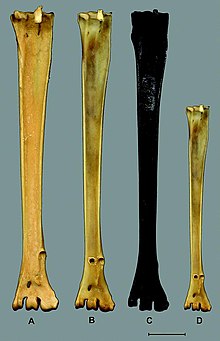 |
| † Errant eagle | † Neogyps errans | In spite of being considered a gypaetine vulture, Neogyps errans is thought to have been more eagle-like in appearance with leg bones somewhat similar to the bearded vulture. Hertel predicted Neogyps to have been a ripper scavenger, meaning it would have been one of the first vultures at a carcass, ripping it open and feeding on tougher elements like the hide. |  | |
| Ferruginous hawk | Buteo regalis | At least 127 individuals. |  | |
| Golden eagle | Aquila chrysaetos | A minimum of 960 individuals. | The most common bird species found in the La Brea tar pits. |  |
| † Grinnell's hawk-eagle | † Spizaetus grinnelli | At least 105 individuals. | A species of hawk-eagle, remains of Spizaetus grinnelli are also known from Florida. | |
| Hawk | Buteo sp. | A group of individuals similar in proportion to the red-shouldered hawk. | ||
| Northern harrier | Circus hudsonius | A minimum of 164 individuals. | 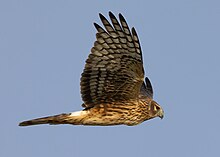 | |
| Northern goshawk | Accipiter gentilis | At least two specimen |  | |
| Red-tailed hawk | Buteo jamaicensis | A minimum of 108 individuals. |  | |
| Rough-legged buzzard | Buteo lagopus | Two tarsometatarsi and a femur | 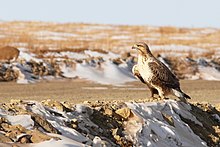 | |
| Sharp-shinned hawk | Accipiter striatus velox | Five specimen |  | |
| Swainson's hawk | Buteo swainsoni | At least 130 individuals | A species of hawk that primarily feeds on insects. Unlike other bird species found at La brea, which are typically larger than their modern counterparts, the Swainson's hawk appears to have undergone a size increase. Modern individuals are more robust than those found in the tar pits. |  |
| † Woodward's eagle | Buteogallus woodwardi | B. woodwardi was previously regarded as a species of Amplibuteo before taxonomic revisions. |  |
Anseriformes
| Common name | Species | Material | Notes | Image |
|---|---|---|---|---|
| Cf. Brant goose | Branta cf. bernicla |  | ||
| Canada goose | Branta canadensis |  | ||
| Canvasback | Aythya valisineria |  | ||
| Cinnamon teal | Spatula cyanoptera |  | ||
| Green-winged teal | Anas carolinensis | Multiple specimens | One of the first duck species recorded at La Brea. This species is well recorded in both the academy and museum pits. |  |
| Gadwall | Mareca strepera |  | ||
| † Graceful pygmy goose | † Anabernicula gracilenta | At least 150 specimen representing 23 to 24 individuals | An extinct species of shellduck. The average pygmy goose from La Brea was found to be smaller than those from the McKittrick tar pits. | |
| Greater white-fronted goose | Anser albifrons | Several tarsometatarsi and femora | According to Howard, the La Brea material includes sizes that fall within the range of both modern subspecies. |  |
| Mallard | Anas platyrhynchos | Multiple specimens | Mallards are well represented in both the academy and museum pits. Mallards were among the first ducks identified at La Brea. | 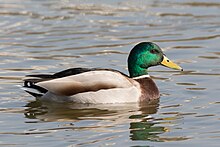 |
| Northern shoveler? | Spatula clypeata? | Multiple specimens including fused carpal phalanges | Remains are of similar size as those of modern shovelers. |  |
| Ross's goose? | Anser rossi? | Several tarsometatarsi | Skeletal elements of this species are assigned to it on the basis of their lesser size compared to the snow goose. However this is deemed to be tentative as the difference could also be explained by intraspecific size variation. |  |
| Snow goose | Anser caerulescens | Femora and tarsometatarsi | According to Hildegarde Howard, snow goose material from La Brea indicates that this species attained larger sizes during the Pleistocene than today. | 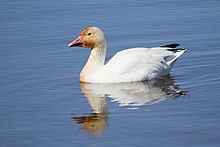 |
| Tundra swan | Cygnus columbianus | A carpometacarpus, femur and possible tarsometatarsus |  |
Caprimulgiformes
| Common name | Species | Material | Notes | Image |
|---|---|---|---|---|
| Common poorwill | Phalaenoptilus nuttallii | Seven specimen |  |
Cathartiformes
| Common name | Species | Material | Notes | Image |
|---|---|---|---|---|
| † Cathartornis gracilis | 2 tarsometatarsi | A poorly known teratorn only known from two bones. Although additional material has been considered to be referable to it, said fossils remain undescribed. |  | |
| † Gymnogyps amplus | A species of condor larger and more robust than the modern Californian condor. It is possible that this species gave rise to the modern form some time during the early Holocene, however due to the timing of this size decrease it is thought that the changes were not a direct response to the extinction of the Pleistocene megafauna. |  | ||
| † La Brea black vulture | † Coragyps occidentalis | A species of black vulture also known as the Pleistocene black vulture. Although initially thought to be ancestral to the modern form, later studies showed that instead they evolved from South American black vultures that specialised in colder high-altitude environments. Hertel classified the La Brea black vulture as a scrapper scavenger, more specialised in feeding on small scraps. |  | |
| † La Brea condor | Breagyps clarki | Hertel considers Breagyps to be a gulper in regards to scavenging style, though with the most deviating anatomy compared to the other contemporary gulp scavengers. This is due to the vulture's elongated and narrow beak. Fisher described Breagyps as a generalized vulture with a cranium similar to the two modern condor species and a beak reminiscent of the black vulture. |  | |
| † Merriam's teratorn | Teratornis merriami | Over 100 individuals | A large bodied teratorn with a wingspan between 3.5–3.8 m (11–12 ft). Despite being commonly depicted as vulture-like scavengers, the cranial anatomy of teratorns indicates that they were active predators built to swallow prey whole. Consequently, Merriam's teratorn would have likely preyed on animals such as frogs, lizards, small birds and rodents. |  |
| Turkey vulture | Cathartes aura | 34 specimen | Although turkey vultures found in La Brea are considered to be part of the same species as modern populations, the fossils indicate that they were slightly larger. Additionally, this Pleistocene form was more adapted towards feeding on larger chunks of carrion compared to the more recent representatives of the species. |  |
Ciconiiformes
| Common name | Species | Material | Notes | Image |
|---|---|---|---|---|
| † Asphalt stork | Ciconia maltha | A widespread species of stork with great intraspecific variation. The asphalt stork was described based on material from La Brea, but has since then found in multiple other localities across the United States. Individual asphalt storks could have reached a height of 1.5 m (4 ft 11 in) and a wingspan of 3 m (9.8 ft). | ||
| † Mycteria wetmorei | A mandible and the end of a tarsometatarsus. | An extinct relative of the modern wood stork, Mycteria wetmorei was larger than the extant species and had a straighter mandible that was more similar to that seen in the African and Asian species. |
Charadriiformes
| Common name | Species | Material | Notes | Image |
|---|---|---|---|---|
| American avocet | Recurvirostra americana | Five specimens |  | |
| † La Brea lapwing | † Belonopterus downsi | Right carpometacarpus and a partial humerus | An extinct species of lapwing most closely related to species from South America. Its size is intermediate between the southern lapwing and the Andean lapwing. | |
| Black-legged kittiwake? | Rissa tridactyla? | A coracoid | Possible remains of the black-legged kittiwake are known from La Brea. However the identification is not certain. | 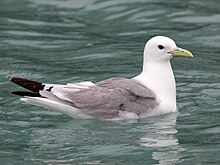 |
| Dunlin | Calidris alpina |  | ||
| Greater yellowlegs | Tringa melanoleuca | Several specimen | 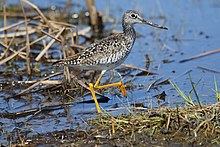 | |
| Grey plover | Pluvialis squatarola | Several specimen |  | |
| Killdeer | Charadrius vociferus | A humerus and tarsometatarsus | Miller regarded the presence of killdeers at La Brea as unsurprising given the species' appearance in modern inland sloughs and meadows. | 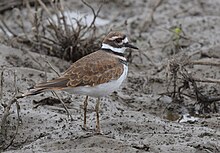 |
| Long-billed curlew | Numenius americanus | Right tarsometatarus and a left coracoid | The bones from La Brea show no difference from modern curlews. |  |
| Marbled godwit? | Limosa fedoa? | Material of the tarsometatarsus and tibiotarsus | Fossil material assigned to the marbled godwit closely resembles material of modern specimens in shape and size. However, due to the incomplete nature of the material the assignment is considered to be only tentative by Howard. |  |
| Red phalarope | Phalaropus fulicarius |  | ||
| Sanderling | Calidris alba |  | ||
| Short-billed dowitcher | Limnodromus griseus | A coracoid and an incomplete humerus | Miller regards the presence of dowitchers as less expected than that of killdeers, but argues that birds with similar habits are known to take breaks around small freshwater ponds. It could have been during one such break that a dowitcher may have gotten stuck in the asphalt. |  |
| Short-billed gull? | Larus brachyrhynchus? | A humerus | A species of gull which at times was considered to be conspecific with the European common gull, causing it to be identified as Larus canus in some publications. The La Brea humerus may have belonged to this species on account of its size. |  |
| Whimbrel | Numenius phaeopus hudsonicus |  | ||
| Willet | Tringa semipalmata |  | ||
| Wilson's snipe | Gallinago gallinago delicata |  |
Columbiformes
| Common name | Species | Material | Notes | Image |
|---|---|---|---|---|
| Band-tailed pigeon | Patagioenas fasciata | At least three specimens belonging to a minimum of three individuals | Stock notes that band-tailed pigeons were relatively rare in the tar seeps of La Brea, which Howard argues may reflect the environmental conditions. This matches the fact that band-tailed pigeons prefer forest habitats, while Pleistocene La Brea is thought to have been more open. |  |
| Mourning dove | Zenaida macroura | 29 specimens belonging to a minimum of 17 individual birds | Mourning doves are considerably more common than the other pigeon species found in the asphalt seeps. This reflects the bird's preferred habitat, with the mourning dove frequenting more open areas than its two contemporaries. |  |
| † Passenger pigeon | † Ectopistes migratorius | Six fossils belonging to at least three individuals | Although initially thought to have been an exclusively northern and eastern species, bones found in La Brea and New Mexico eventually showed that the passenger pigeon was found on both coasts during the Pleistocene. Although Howard argued that its abundance cannot be determined, its rarer nature matches that of the band-tailed pigeon which has a similar preference for forests. | 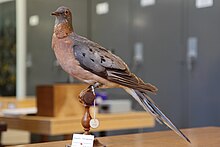 |
Cuculiformes
| Common name | Species | Material | Notes | Image |
|---|---|---|---|---|
| Greater roadrunner | Geococcyx californianus | 25 specimen | Due to the relatively mild winters of the region the La Brea population of the roadrunner shows no significant size difference towards their modern relatives, unlike Pleistocene populations that lived further inland. |  |
Falconiformes
| Common name | Species | Material | Notes | Image |
|---|---|---|---|---|
| American kestrel | Falco sparverius | 79 specimens |  | |
| Falcon | Falco sp. | An indetermined species of falcon. | ||
| † La Brea caracara | † Caracara plancus prelutosus | It was initially established by Hildegarde Howard as a distinct species, Polyborus pelutosus, but this notion was later rejected by Storrs Olson. Olson considered both the northern and southern caracara to be nothing but subspecies and subsequently argued that the traits of the La Brea caracara would fall within the variation of this combined species. Regardless, the animal is still considered to be a valid temporal subspecies. Later revisions caused the genus name to be changed from Polyborus to Caracara. |  | |
| Merlin | Falco columbarius | 16 specimen |  | |
| Peregrine falcon | Falco peregrinus | 29 specimen | 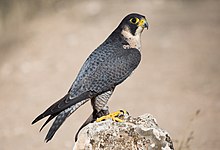 | |
| Prairie falcon | Falco mexicanus | 24 specimen |  |
Galliformes
| Common name | Species | Material | Notes | Image |
|---|---|---|---|---|
| † Californian turkey | Meleagris californica | Over 11.000 fossil specimens belonging to almost 800 individual birds. | One of the most common birds at the La Brea tar pits, the Californian turkey is most closely related to the modern wild turkey, from which it likely evolved after a population became isolated in California. In size it was intermediate between the two modern turkey species. |  |
| California quail | Callipepla californica | 138 specimens |  |
Gruiformes
| Common name | Species | Material | Notes | Image |
|---|---|---|---|---|
| American coot | Fulica americana | A tibiotarsus | 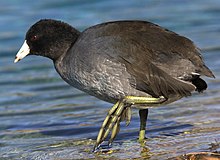 | |
| † Grus pagei | At least 17 individuals based on 42 fossil bones | A gracile crane that was comparable in size to the smallest modern sandhill crane individuals, but notably smaller than members of the species found at La Brea. Besides size the two cranes differ in the anatomy of the skull, which is larger and more slender in Grus pagei. | ||
| Sandhill crane | Antigone canadensis | 417 fossils corresponding to at least 52 individuals | Sandhill crane fossils found in the tar pits indicate that individuals of this species grew to much larger sizes during the Pleistocene. The species Grus minor, described from the La Brea tar pits, was later found to be a synonym of the sandhill crane. | 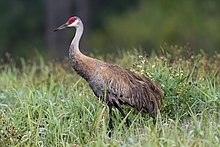 |
| Whooping crane | Grus americana | A minimum of 45 specimens representing at least 8 individuals | The largest but also rarest of the La Brea crane species. While Grus pagei and the sandhill crane were commonly found together, whooping cranes appear in less than half of the same pits as the other cranes. |  |
Strigiformes
| Common name | Species | Material | Notes | Image |
|---|---|---|---|---|
| Asio sp. | 159 fossils of 46 individuals | Various owl remains found in La Brea are not diagnostic enough to be assigned to either of the two Asio species found in the pits. The material however shows no signs of belonging to a distinct third species. | ||
| Barn owl | Tyto alba | Almost 2.000 specimens amounting to at least 253 individuals. | The barn owl is among the most common owls found in the La Brea tar pits, second only to the burrowing owl. This matches with the barn owl's preference for open environments with scattered trees. | 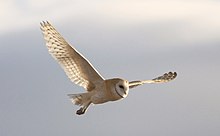 |
| † Brea miniature owl | † Asphaltoglaux cecileae | 4 fossils of 3 individuals. | The rarest owl found in the pits, the lack of material might have various reasons. Its small size means that they may not have been caught in the asphalt as often as larger animals, additionally, older collections valued large animals over small ones. Fossils of Asphaltoglaux are found in the same pits as those of Kurochkin's pygmy owl, which could suggest that these particular pits were located in less open environments more suited to these small owl species. Asphaltoglaux is similar to and may be related with owls of the genus Aegolius. |  |
| Burrowing owl | Athene cunicularia | Over 2.700 specimens belonging to almost 400 animals. | The most common owl of La Brea, burrowing owl fossils make up 35% of all owl fossils and 34% of all individuals. This abundance can at least partially be explained by the species' habitat preferences, as burrowing owls prefer open environments such as prairies, grasslands and deserts. This matches the environment of La Brea, which is generally considered to have been open with no proper forests. Being ground dwellers also means that these owls are more likely to come in contact with the asphalt seeps. |  |
| Great horned owl | Bubo virginianus | 1.280 fossils of at least 131 owls. | The great horned owl is the fourth most common owl species found at La Brea. It is known to inhabit a wide range of environments including more wooded areas, however according to Campbell and Bochenski the species prefers to forage in more open environments. Regardless, the authors note that the weight of this bird would work against it when getting stuck, meaning that although it may not come into contact with the tar as commonly the risk of being unable to move is increased. |  |
| † Kurochkin's pygmy owl | † Glaucidium kurochkini | 12 fossil specimens belonging to at least 6 individuals. | Although it is difficult to determine habitat preferences of the extinct La Brea owls, Campbell and Bochenski argue that they would likely be similar to those of extant Glaucidium species, which prefer woodlands over open landscape. This is further supported by the fact that it is found alongside Asphaltoglaux in the same pits, an owl that may have also preferred more forested areas. G. kurochkini was approximately the size of the modern mountain pygmy owl, which the fossils were assigned to before being recognized as a distinct species. |
 |
| † La Brea owl | † Oraristrix brea | 144 fossil specimens belonging to at least 28 birds. | A large owl similar in size to the great grey owl and the great horned owl. Specimens of this owl are most commonly found in pits that also contain high numbers of the later species, indicating that they may have overlapped in prey preferences or hunting methods. It was a slender bird with longer limbs, which have been interpretet to correspond with more terrestrial habits, potentially living in coastal shrubland rather than forests. | |
| Long-eared owl | Asio otus | 173 specimens accounting for at least 50 individuals. | Unlike the related short-eared owl, the long-eared owl is relatively more rare in the La Brea pits. This might be due to the species' preference for wooded areas, although it does not require closed canopy forests. Additionally, unlike many of the more common owls known from fossil material, the long-eared owl is much more strictly nocturnal. This means that the tar would be much cooler when this species hunts, decreasing the risk of getting stuck. | 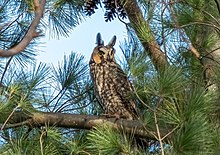 |
| Western screech owl | Megascops kennicottii | 79 fossils of 22 birds. | The western screech owl is known to have similar habitat preferences and periods of activity as the long-eared owl. |  |
| Short-eared owl | Asio flammeus | Close to 1.400 fossil specimens belonging to a minimum of 186 birds. | Much like the burrowing owl and barn owl, the short-eared owl shows a preference for open environments in its modern range, explaining why the species is so abundant in the La Brea tar pits. The fact that this owl is also more diurnal, like the burrowing owl, presents an additional risk as the asphalt is stickier during the warm days. |  |
Passeriformes
| Common name | Species | Material | Notes | Image |
|---|---|---|---|---|
| American crow | Corvus brachyrhynchos | 22 specimens | 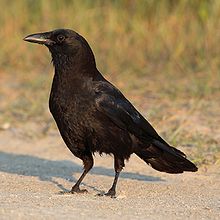 | |
| American goldfinch | Spinus tristis | Three specimens including at least one upper and one lower mandible | Golfinches may have inhabited the open fields and meadows of La Brea as well as the weedy borders of these habitats. They were resident birds during the Last Glacial Maximum, but are only present during the winter today. | 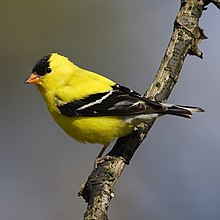 |
| American robin | Turdus migratorius | 18 specimens |  | |
| Bell's sparrow | Amphispiza belli | Seven mandibles | Material of the Bell's sparrow was reported alongside that of the black-throated sparrow by Sibley (1939). |  |
| Black-headed grosbeak | Pheucticus melanocephalus | Upper and lower mandible | The oak trees known from La Brea would have offered a suitable habitat for this species. |  |
| Black-throated sparrow | Amphispiza bilineata | Upper and lower mandibles | Although today preferring desert environments with sparse vegetation and contrasting with some of the other passerines from La Brea, the shrew Notiosbrex also found in the tar pits is known to have similar environmental preferences. |  |
| Brown-headed cowbird | Molothrus ater | A single specimen |  | |
| California scrub jay | Aphelocoma californica | Eight specimen | One of several birds that likely inhabited the oak forests at La Brea. |  |
| California thrasher | Toxostoma redivivum | Six specimen including a cranial fragment |  | |
| Canyon towhee | Pipilo fuscus | Two incomplete lower mandibles | A towhee species notably smaller than spotted towhee, which was initially thought to be present at La Brea. |  |
| Cassin's kingbird | Tyrannus vociferans | Four specimen | Although today only breeding in the region around La Brea, it was a resident species during the Pleistocene. |  |
| Cedar waxwing | Bombycilla cedrorum |  | ||
| Chihuahuan raven | Corvus cryptoleucus | A single specimen | As the distribution of this species during the Last Glacial Maximum appears to be inconsistent with its presence at La Brea, Zink and colleagues argue that this might be a case of misidentification. |  |
| Chipping sparrow | Spizella passerina | Six specimen |  | |
| Clark's nutcracker | Nucifraga columbiana | Two specimen |  | |
| Common raven | Corvus corax | 114 specimen | One of the most common La Brea passerines, ravens from the pits show no response to the changing climate conditions caused by the Last Glacial Maximum. They were however more robust than their modern descendents. |  |
| Eastern towhee | Pipilo erythrophthalamus | 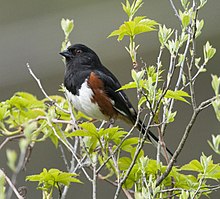 | ||
| † La Brea blackbird | † Euphagus magnirostris | A single specimen | A species of blackbird also known as the large-billed blackbird. Although first described from La Brea, its fossils were later also found in Peru and Venezuela. | |
| Evening grosbeak | Coccothraustes vespertinus | A single lower mandible | The La Brea material shows the same heavy symphysis as modern evening grosbeaks and further resembles them in the details of the mandible. Although it is a wandering species, individuals of this species are known to appear in modern Los Angeles. | 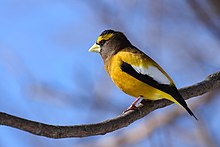 |
| Fox sparrow | Passerella iliaca | Two lower mandibles | The two La Brea mandibles are of different size, falling within the ranges of the larger and smaller modern subspecies. | 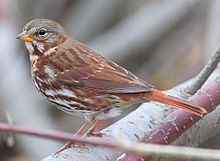 |
| Indeterminate Fringillidae | ||||
| Horned lark | Eremophila alpestris | At least one specimen | This species is less abundant in La Brea compared to other Pleistocene tar pits like the McKittrick tar seeps. |  |
| Icterus spp. | ||||
| Lark sparrow | Chondestes grammacus | Three upper mandibles | The mandibles are assigned to the genus Chondestes and further to the lark sparrow due to the fact that it is the only known species of the genus. | 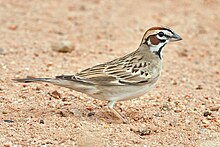 |
| Loggerhead shrike | Lanius ludovicianus | Three specimen |  | |
| Cf. Mountain chickadee | Poecile gambeli |  | ||
| Northwestern crow | Corvus caurinus |  | ||
| † Convex-billed cowbird | † Pandanaris convexa | Upper and lower rostrum | A species of New World blackbirds with a short and deep beak, much more robust than that of the La Brea blackbird. | |
| Indeterminate Parulinae | ||||
| Pine siskin | Carduelis pinus | 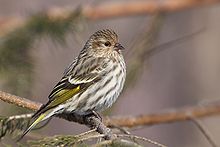 | ||
| † Pipilo angelensis | Two upper mandibles and six lower mandibles | A species of towhee first described from La Brea as Pipilo angelensis. It was of larger size than any modern Pipilo species. | ||
| Cf. Red-winged blackbird | Agelaius phoeniceus californicus |  | ||
| Sage thrasher | Oreoscoptes montanus | One specimen |  | |
| Song Sparrow | Melospiza melodia | Ten upper mandibles | The fossils are larger in size than the mandibles of the Lincoln's and swamp sparrow, instead matching the song sparrow the closest. |  |
| Indeterminate sparrow | Spizella sp. | Six upper mandibles | The size of the nostrils in the most complete specimen resemble the American tree sparrow, however due to the fragmentary nature of the material no assignment is made. | |
| Steller's jay | Cyanocitta stelleri | Four specimen |  | |
| Vesper sparrow | Pooecetes gramineus | A single upper mandible | The La Brea fossil resembles material of the modern vesper sparrow, which is the only known extant species of Pooecetes from North America. | 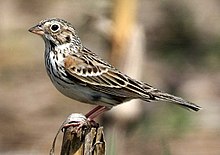 |
| Cf. Western bluebird | Sialia mexicana | Seven specimen |  | |
| Western meadowlark | Sturnella neglecta | 125 specimen | Western meadowlarks are more common at La Brea compared to the McKittrick tar seeps and among the most common small birds in the asphalt seeps. |  |
| White-crowned sparrow | Zonotrichia leucophrys | Three upper mandibles | Although two species of Zonotrichia are present in Los Angeles today, the fossil material matches the nostril shape of Z. leucophrys. | 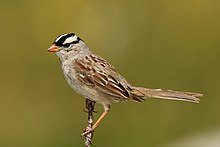 |
| Yellow-billed magpie | Pica nuttalli | 174 specimen | One of the most common passerines at La Brea, there appears to be no response by magpies to the climate conditions changing during the Last Glacial Maximum. |  |
| Yellow-headed blackbird | Xanthocephalus sp. | 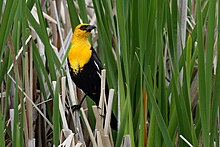 |
Pelecaniformes
| Common name | Species | Material | Notes | Image |
|---|---|---|---|---|
| American bittern | Botaurus lentiginosus |  | ||
| Black-crowned night heron | Nycticorax nycticorax |  | ||
| Great blue heron | Ardea herodias |  | ||
| Great egret | Ardea alba | A tibiotarsus and coracoid |  | |
| Little blue heron? | Egretta caerulea? | A tarsometatarsus | The presence of the little blue heron at La Brea is deemed questionable due to the possible confusion with the tricolored heron. |  |
| Roseate spoonbill | Platalea ajaja |  | ||
| Snowy egret? | Egretta thula? | Several specimens | Although the material matches what is known from snowy egrets, early descriptions were uncertain about the assignment due to the lack of comparative material with the little blue and tricolored heron. | 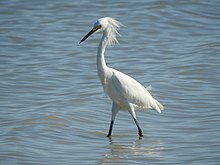 |
| Striated heron | Butorides striatus | A tibiotarsus | These remains were initially assigned to the green heron, but later referred to the related striated heron instead. |  |
| White-faced ibis | Plegadis chihi | Pleistocene records of this species are only known from La Brea and Térapa, Sonora. | 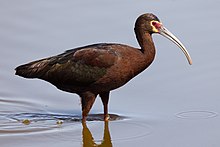 |
Piciformes
| Common name | Species | Material | Notes | Image |
|---|---|---|---|---|
| † Bitumenpicus minimus | 8 fossil specimens that could belong to a single individual | The smallest woodpecker at La Brea, it was similar in size to Nuttall's woodpecker. | ||
| † Breacopus garretti | A carpometacarpus and the distal end of a tibiotarsus | The largest woodpecker found in the region, it was approximately the size of a modern pileated woodpecker. Its size suggests that large trees must have been present to some degree, probably scattered across the more open environment. The bones of Breacopus were initially misidentified as having belonged to the pileated woodpecker and although some bones referred to the modern species could not be located, Campbell and Bochenski argue that the missing material also likely represents Breacopus remains. | ||
| Lewis's woodpecker | Melanerpes lewisi | 92 specimens belonging to at least 18 individual birds | A species of woodpecker still native to the region today. Its remains are common in the tar pits, possibly due to its habit of pursuing insects in flight. This would lead it closer to the asphalt seeps than woodpeckers drilling for food. |  |
| † Melanerpes shawi | 18 specimens corresponding to at least 4 individuals | Melanerpes shawi was similar in size to the contemporary Lewis's woodpecker, making it one of the largest members of the genus. | ||
| Northern flicker | Colaptes auratus | 317 specimens suggesting a minimum of 38 individuals | The most numerous woodpecker found in the La Brea tarpits, likely due to its more terrestrial lifestyle. This would bring it into contact with the tar more commonly and thus lead to increased likelihood of being preserved. |  |
| Piciformes indet. | 8 specimens | Woodpeckers similar in size to Sphyrapicus that could not be referred to any particular genus. | ||
| Red-breasted sapsucker | Sphyrapicus ruber | A total of 26 specimens belonging to at least 4 individuals | As this species prefers open woodland, this species indicates that the environment of Rancho La Brea was relatively open. Howard reported at least three instances of Sphyrapicus sp. as well; of which one was lost, another was referred to S. ruber while the third could not be identified to species level. |  |
Podicipediformes
| Common name | Species | Material | Notes | Image |
|---|---|---|---|---|
| Grebe | Podiceps sp. | A humerus | A grebe or loon, initially identified as Colymbus sp. by Miller and Howard, although Howard wrote that it might also belong to Podilymbus. Stock later listed the specimen as belonging to Podiceps. | |
| Pied-billed grebe | Podilymbus podiceps | A femur | The Grebe fossil was discovered in pit 16. |  |
Suliformes
| Common name | Species | Material | Notes | Image |
|---|---|---|---|---|
| Cormorant | Phalacrocorax sp. |
Reptiles
| Common name | Species | Material | Notes | Image |
|---|---|---|---|---|
| California whipsnake | Masticophis lateralis | Mid and posterior trunk vertebrae | The first fossil material of this species was discovered at La Brea. It inhabited foothills, forests as well as chaparral, grassy and brushy regions. |  |
| Centipede snake | Tantilla sp. | Multiple mid and posterior trunk vertebrae | Although the fossils match the western black-headed snake, which also occurs in California today, the material is not assigned to any particular species due to the often restricted range of centipede snakes and the fact that members of the genus are poorly understood. |  |
| Coast horned lizard | Phrynosoma coronatum | Although present in La Brea during the Pleistocene, the coast horned lizard is now absent from the Los Angeles-Orange County basin, seemingly having gone extinct before the first historical records. |  | |
| Common garter snake | Thamnophis sirtalis | Mid trunk vertebrae | Common garter snakes are commonly found near aquatic environments. Unlike many of the other snakes from Rancho La Brea, it is not commonly found in the modern Los Angeles area, which is situated at the southern edge of its range. |  |
| Common kingsnake | Lampropeltis getula | A maxilla and multiple vertebrae | A medium to large sized snake most active during the twilight hours and night. It ranges over a great area over the southern USA and is found in various Pleistocene localities. | 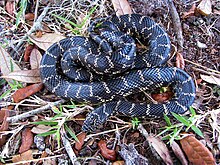 |
| Common side-blotched lizard | Uta stansburiana | A desert lizard known to also enter wood- and shrublands, its fossils are common at Rancho La Brea. |  | |
| Desert night lizard? | Xantusia vigilis? | Remains of Xantusia were originally reported by Brattstrom in 1953, but later publications have called the identification into question, suggesting the fossils may have been those of an iguana in the genus Uta instead. | 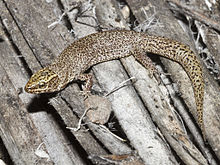 | |
| Desert spiny lizard | Sceloporus magister | While the western fence lizard is still present in California, the desert spiny lizard has disappeared from the area and instead retreated to more arid regions. |  | |
| Eumeces sp. | An skink assigned to the Eumeces genus. This genus underwent taxonomic revisions and American species have since then been placed in either Plestiodon or Mesoscincus. | |||
| Garter snake | Thamnophis sp. | Over 900 specimen in pit 91 | Remains of a snake within the genus Thamnophis that is not clearly identifiable as either of the two species known from the tar pits. Remains of Thamnophis sp. make up 64% of the snake fauna at pit 91. | |
| Indetermined tortoise | A land tortoise initially assigned to Geochelone. However, since then many species previously included in this genus were split into their own genera, with true members of Geochelone being endemic to Asia. | |||
| Glossy snake | Arizona elegans | A few vertebrae | An open environment snake found in grasslands and chaparral. |  |
| Great plains rattlesnake | Crotalus viridis | A dentary and various vertebrae | The only rattlesnake from Pleistocene South California identified to the species rank. It is known to have inhabited a wide range of environments excluding for deserts. |  |
| Kingsnake | Lampropeltis sp. | |||
| Legless lizard | Anniella sp. | Two isolated vertebrae | An indetermined species of legless lizard from Pit 91. |  |
| Long-nosed snake | Rhinocheilus lecontei | Two vertebrae | A nocturnal snake inhabiting prairies, deserts and bushlands. It is still found in Los Angeles today. Within pit 91 it is the rarest occurring snake. |  |
| Night snake | Hypsiglena torquata | Multiple mid and posterior trunk vertebrae as well as anterior trunk vertebrae, precloacal vertebrae and juvenile remains | Assignment to H. torquata was primarily based on geography. Although falling in the range of variation of the modern form, the fossil did show relatively shorter vertebrae. |  |
| Pine snake | Pituophis melanoleucus | Multiple maxillae, a pterygoid and compound bone and great number of vertebrae | A common snake found at various Late Pleistocene sites, matching its generalist lifestyle not specialised in any particular habitat. |  |
| Rattlesnake | Crotalus sp. | |||
| Ring-necked snake | Diadophis punctatus | A maxilla, compound bone and a great number of mid trunk vertebrae. The allocated material includes anterior trunk vertebrae as well as material of juvenile individuals. | A snake that occurs in Los Angeles to this day, it prefers wetter environments including woodlands but can be found in more arid regions next to rivers. |  |
| Sceloporine indet. | Various cranial and postcranial remains | Multiple remains referred the Sceloporus-group of Phrynosomatidae. No genus or species assignment could be made. | ||
| cf. Sierra garter snake | Thamnophis cf. couchii | Mid and posterior trunk vertebrae | Due to taxonomic revisions of T. couchii it is not entirely certain which species this snake may have belonged to. Some members of the former T. couchii group, including T. couchii itself, were more waterbound while others were more terrestrial. |  |
| Southern alligator lizard | Elgaria multicarinata |  | ||
| Western fence lizard | Sceloporus occidentalis | The western fence lizard is still commonly found in coastal south California. |  | |
| Western pond turtle | Actinemys marmorata | A freshwater turtle that appears to not differ ecologically from the modern form. | 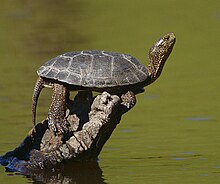 | |
| Western skink | Plestiodon skiltonianus |  | ||
| Western whiptail | Aspidoscelis tigris | A long-tailed teiid lizard primarily found in arid regions. |  | |
| Western yellow-bellied racer | Coluber constrictor mormon | A maxilla, compound bone and a great number of various vertebrae | A well represented snake species known to inhabit semiarid to moist open environments. |  |
Amphibians
| Common name | Species | Material | Notes | Image |
|---|---|---|---|---|
| Arboreal salamander | Aneides lugubris |  | ||
| Arizona toad | Anaxyrus microscaphus | 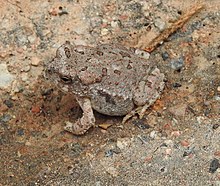 | ||
| California toad | Anaxyrus boreas halophilus | Although initially described as a distinct species from La Brea, Anaxyrus nestor was later considered to be synonymous with the California toad. |  | |
| Northern red-legged frog | Rana aurora | A radioulna and a vertebra |  | |
| Tree frog | Hyla sp. |
Fish
| Common name | Species | Material | Notes | Image |
|---|---|---|---|---|
| Arroyo chub | Gila orcutti | 4 bones consisting of a dentary and three vertebrae | The largest vertebrae indicate trout with a standard length of 6.2 cm (2.4 in). |  |
| Rainbow trout | Oncorhynchus mykiss | 15 bones consisting of isolated vertebrae | The largest vertebrae indicate trout with a standard length of 15 cm (5.9 in). | 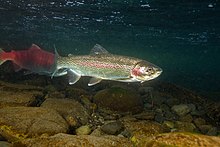 |
| Three-spined stickleback | Gasterosteus aculeatus | 51 bones consisting of pelvic spines, vertebrae and parts of the pelvis belonging to at least 23 individuals | The spines indicate that the sticklebacks of La Brea reached standard length of 3.5–4 cm (1.4–1.6 in). |  |
Arthropods
Arachnids
| Common name | Species | Material | Notes | Image |
|---|---|---|---|---|
| Harvestmen | ||||
| Scorpions | ||||
| Spiders |
Crustaceans
| Common name | Species | Material | Notes | Image |
|---|---|---|---|---|
| Pill bugs | ||||
| Water fleas |
Insects
Myriapods
| Common name | Species | Material | Notes | Image |
|---|---|---|---|---|
| Centipedes | ||||
| Hiltonius australis | ||||
| Millipedes |  |
Diatoms
Achnanthaceae
| Genus | Species | Authority | Notes | Image |
|---|---|---|---|---|
|
(Breb.) Grun. |
 | |||
| Cocconeis |
(Ehr.) V.H. |
|||
|
W. Smith |
Coscinodiscaceae
| Genus | Species | authority | Notes | Image |
|---|---|---|---|---|
| Coscinodiscus | ||||
| Melosira | ||||
Cymbellaceae
| Genus | Species | authority | Notes | Image |
|---|---|---|---|---|
| Amphora |
(Ag.) Kutz. |
|||
|
Rabh. |
||||
|
(Kutz.) V.H. ex DeT. |
||||
|
(Kutz.) V.H. ex DeT. |
||||
|
Kutz. |
||||
| Cymbella |
(Ehr.) Kirchn. |
|||
|
(Ehr.) Cl. |
||||
|
Hust. |
Epithemiaceae
| Genus | Species | authority | Notes | Image |
|---|---|---|---|---|
| Denticula |
Kutz. |
|||
|
(Grun.) DeT. |
||||
|
J.W. Bail. |
||||
| Epithemia |
(Perag. & Herb) Patr. |
|||
|
Andrews |
||||
|
Fricke |
||||
|
(Ehr.) Kutz. |
||||
|
(Ehr.) Grun. |
||||
| Rhopalodia |
(Ehr.) O. Mull. |
|||
|
(Ehr.) O. Mull. |
||||
|
(Kutz.) O. Mull. |
Fragilariaceae
| Genus | Species | authority | Notes | Image |
|---|---|---|---|---|
| Fragilaria | ||||
|
(Ehr.) |
||||
| Synedra |
(Grev.) |
|||
Gomphonemaceae
| Genus | Species | authority | Notes | Image |
|---|---|---|---|---|
| Gomphonema | ||||
|
Greg. |
||||
|
(Kutz.) Rabh. |
||||
|
(Kützing) Kützing, 1849 |
||||
|
(Grun.) A. Maye |
Nitzchiaceae
| Genus | Species | authority | Notes | Image |
|---|---|---|---|---|
| Nitzschia |
Grun. |
|||
|
Grun. |
||||
|
Grun. |
||||
|
(Kutz.) Grun. |
||||
|
Grun. |
||||
|
Krasske |
||||
|
(Kutz.) W. Sm. |
Naviculaceae
| Genus | Species | authority | Notes | Image |
|---|---|---|---|---|
| Caloneis |
(Grun.) Cl. |
|||
|
Patr. |
||||
|
(Kutz.) Patr. |
||||
|
(Grun.) Patr. |
||||
| Diploneis |
(Kutz.) Cl. |
|||
|
(Ehr.) |
||||
|
Hust. |
||||
|
(Thwaites) Cl. |
||||
| Navicula |
Sov. |
|||
|
(Kutz.) |
||||
|
Meist. |
||||
|
(Grun.) Cl. |
||||
|
(Ag.) |
||||
|
Kutz. |
||||
|
(Hilse) Grun. |
||||
|
(Ehr.) Kutz. |
||||
|
Lund |
||||
|
Kutz. |
||||
|
Kutz. |
||||
|
Kutz. |
||||
|
(Grun.) Cl. |
||||
|
(Ehr.) Cl. |
||||
| Pinnularia |
Ehr. |
|||
|
(Kutz.) Rabh. |
||||
|
(Lagerst.) Cl. |
||||
|
(Nitz.) Ehr. |
||||
| Stauroneis |
W. Sm. |
|||
|
(Ehr.) Hust. |
||||
|
Hust. |
Charophyte green algaes
Characeae
| Name | Species | Material | Notes | Image |
|---|---|---|---|---|
| Chara sp. |
Conifers
Cupressaceae
| Name | Species | Material | Notes | Image |
|---|---|---|---|---|
| Californian cypress | Cupressus goveniana |  | ||
| California juniper | Juniperus californica |  | ||
| Coastal Redwood | Sequoia sempervirens | 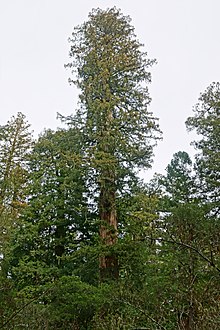 | ||
| Monterey cypress | Cupressus macrocarpa |  | ||
| Tecate cypress | Cupressus forbesii |  | ||
| cf. West Indies juniper | cf. Juniperus barbadensis |
Pinaceae
| Name | Species | Material | Notes | Image |
|---|---|---|---|---|
| Bishop pine | Pinus muricata |  | ||
| Foothill pine | Pinus sabiniana |  | ||
| Monterey pine | Pinus radiata | 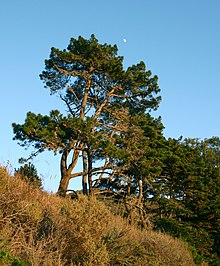 |
Monocot flowering plants
Order Poales
See also: Poales| Name | Species | Material | Notes | Image |
|---|---|---|---|---|
| Chess grass | Bromus sp. |  | ||
| Club-rush | Scirpus spp. | 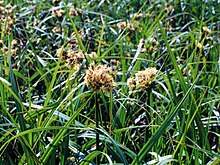 | ||
| Curly mesquite | Hilaria sp. |  | ||
| Festuca sp. |  | |||
| Giant bur-reed | Sparganium eurycarpum |  | ||
| Grama grass | Bouteloua sp. |  | ||
| Spikesedge | Eleocharis sp. |  | ||
| True sedge | Carex sp. |  | ||
| Sacaton grass | Sporobolus sp. |  |
Order Alismatales
See also: Alismatales| Name | Species | Material | Notes | Image |
|---|---|---|---|---|
| Arrowhead | Sagittaria sp. |  | ||
| Horned pondweed | Zannichellia palustris | 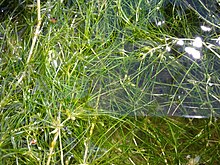 | ||
| Pondweed | Potamogeton sp. |  | ||
| Water-nymph | Najas sp. |  |
Order Liliales
See also: Liliales| Name | Species | Material | Notes | Image |
|---|---|---|---|---|
| Western blue-eyed grass | Sisyrinchium bellum |  |
Dicot flowering plants
Order Campanulales
See also: Campanulales| Common name | Species | Material | Notes | Image |
|---|---|---|---|---|
| Ragweed | Ambrosia sp. |  | ||
| Clustered tarweed | Hemizonia fasciculata |  | ||
| False rosinweed | Osmadenia tenella |  | ||
| Large cocklebur | Xanthium strumarium | 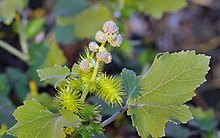 | ||
| Sagebrush | Artemisia sp. |  | ||
| Tarweed | Madia sp. |  | ||
| Thistle | Cirsium sp. |  |
Juglandaceae
| Name | Species | Material | Notes | Image |
|---|---|---|---|---|
| California black walnut | Juglans californica |  |
Salicaceae
| Name | Species | Material | Notes | Image |
|---|---|---|---|---|
| Arroyo willow | Salix lasiolepis |  |
Ulmaceae
| Name | Species | Material | Notes | Image |
|---|---|---|---|---|
| Hackberry | Celtis reticulata |  |
Betulaceae
| Name | Species | Material | Notes | Image |
|---|---|---|---|---|
| White alder | Alnus rhombifolia |  |
Fagaceae
| Name | Species | Material | Notes | Image |
|---|---|---|---|---|
| Coast live oak | Quercus agrifolia |  | ||
| Nuttall's scrub oak | Quercus dumosa | 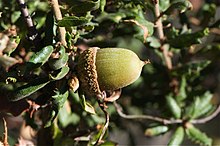 | ||
| Valley oak | Quercus lobata |  |
Caryophyllales
| Name | Species | Material | Notes | Image |
|---|---|---|---|---|
| Wild buckwheat | Eriogonum sp. |  | ||
| Willow dock | Rumex salicifolius |  |
Chenopodiaceae
| Name | Species | Material | Notes | Image |
|---|---|---|---|---|
| Goosefoot | Chenopodium sp. | 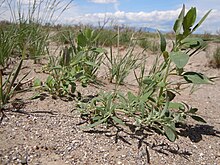 | ||
| Saltbush | Atriplex sp. |  | ||
| Winterfat | Krascheninnikovia lanata | 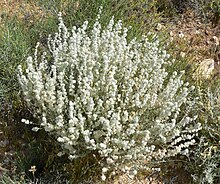 |
Amaranthaceae
| Name | Species | Material | Notes | Image |
|---|---|---|---|---|
| Amaranth | Amaranthus sp. |  |
Portulacaceae
| Name | Species | Material | Notes | Image |
|---|---|---|---|---|
| Fringed redmaids | Calandrinia ciliata |  | ||
| Miner's lettuce | Claytonia perfoliata |  |
Ranunculaceae
| Name | Species | Material | Notes | Image |
|---|---|---|---|---|
| Buttercup | Ranunculus sp. | 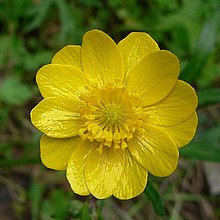 | ||
| Water-crowfoot | Ranunculus aquatilis |  |
Berberidaceae
| Name | Species | Material | Notes | Image |
|---|---|---|---|---|
| Barberry | Berberis sp. |
Lauraceae
| Name | Species | Material | Notes | Image |
|---|---|---|---|---|
| California bay | Umbellularia californica |  |
Platanaceae
| Name | Species | Material | Notes | Image |
|---|---|---|---|---|
| Western sycamore | Platanus racemosa | 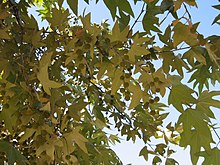 |
Rosaceae
| Name | Species | Material | Notes | Image |
|---|---|---|---|---|
| California blackberry | Rubus vitifolius |  | ||
| Chamise | Adenostoma fasciculatum | 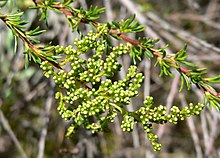 |
Anacardiaceae
| Name | Species | Material | Notes | Image |
|---|---|---|---|---|
| Pacific poison oak | Toxicodendron diversilobum |  |
Aceraceae
| Name | Species | Material | Notes | Image |
|---|---|---|---|---|
| Box elder | Acer negundo |  |
Balsaminaceae
| Name | Species | Material | Notes | Image |
|---|---|---|---|---|
| Deltoid balsamroot | Balsamorhiza deltoidea | 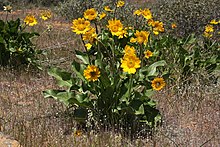 |
Rhamnaceae
| Name | Species | Material | Notes | Image |
|---|---|---|---|---|
| California coffeeberry | Rhamnus californica |  | ||
| Soap bush | Ceanothus sp. |  |
Malvaceae
| Name | Species | Material | Notes | Image |
|---|---|---|---|---|
| Globemallow | Sphaeralcea sp. |  |
Apiaceae
| Name | Species | Material | Notes | Image |
|---|---|---|---|---|
| Lesser water-parsnip | Berula erecta | 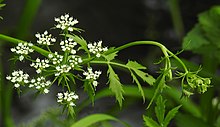 | ||
| Water parsley | Oenanthe sarmentosa |  |
Cornaceae
| Name | Species | Material | Notes | Image |
|---|---|---|---|---|
| Dogwood | Cornus californica |
Ericaceae
| Name | Species | Material | Notes | Image |
|---|---|---|---|---|
| Bigberry manzanita | Arctostaphylos glauca | 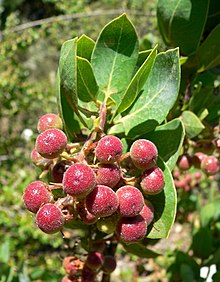 | ||
| Island manzanita | Arctostaphylos insularis |  | ||
| Mission manzanita | Xylococcus bicolor |  | ||
| Morro manzanita | Arctostaphylos morroensis |  | ||
| Pecho manzanita | Arctostaphylos pechoensis | |||
| Pointleaf manzanita | Arctostaphylos pungens |  | ||
| Whiteleaf manzanita | Arctostaphylos viscida |  | ||
| Woollyleaf manzanita | Arctostaphylos tomentosa |  |
Convolvulaceae
| Name | Species | Material | Notes | Image |
|---|---|---|---|---|
| Bindweed | Convolvulus sp. | 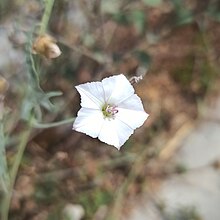 |
Lamiaceae
| Name | Species | Material | Notes | Image |
|---|---|---|---|---|
| Sage | Salvia sp. |  |
Scrophulariacaea
| Name | Species | Material | Notes | Image |
|---|---|---|---|---|
| Nuttall's snapdragon | Antirrhinum nuttallianum |  | ||
| Purple owl's clover | Orthocarpus purpurascens |  |
Verbenaceae
| Name | Species | Material | Notes | Image |
|---|---|---|---|---|
| Verveine | Verbena spp. | 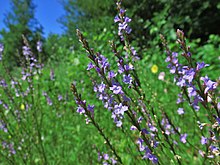 |
Rubiaceae
| Name | Species | Material | Notes | Image |
|---|---|---|---|---|
| Three-petal bedstraw | Galium trifidum |  |
Caprifoliaceae
| Name | Species | Material | Notes | Image |
|---|---|---|---|---|
| Mexican elderberry | Sambucus mexicana | 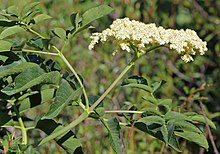 |
Notes
- ^ It is unclear in Zink et al. (2020) whether or not "specimen" refers to the total amount of fossil material or the minimum amount of individual animals that can be extrapolated from the material. The paper contains data that seems to correspond to the former sometimes and the later at other points.
References
- ^ "Research & Collections | la Brea Tar Pits".
- "Fauna and Flora of Rancho La Brea" Archived 2008-12-04 at the Wayback Machine (last visited April 13, 2013).
- Museum, La Brea Tar Pits and (24 June 2015). "Collections". La Brea Tarpits and Museum.
- Baskin, J.; Thomas, R. (2016). "A review of Camelops (Mammalia, Artiodactyla, Camelidae), a camel from the Middle and Late Pleistocene (Irvingtonian and Rancholabrean) of North America". Historical Biology. 28 (1–2): 120–127. doi:10.1080/08912963.2015.1020800. S2CID 83931251.
- ^ Jones, D.B.; Desantis, L.R.G. (2017). "Dietary ecology of ungulates from the La Brea tar pits in southern California: A multi-proxy approach". Palaeogeography, Palaeoclimatology, Palaeoecology. 466: 110–127. Bibcode:2017PPP...466..110J. doi:10.1016/j.palaeo.2016.11.019. ISSN 0031-0182.
- ^ Yann, L.T.; DeSantis, L.R.G.; Koch, P.L.; Lundelius, E.L. (2016). "Dietary ecology of Pleistocene camelids: Influences of climate, environment, and sympatric taxa". Palaeogeography, Palaeoclimatology, Palaeoecology. 461: 389–400. Bibcode:2016PPP...461..389Y. doi:10.1016/j.palaeo.2016.08.036. ISSN 0031-0182.
- Scott, E.; Cox, S.M. (2008). "Late Pleistocene distribution of Bison (Mammalia; Artiodactyla) in the Mojave Desert of southern California and Nevada. Geology and Vertebrate Paleontology of Western and Southern North America". Contributions in Honor of David P. Whistler (X. Wang and L.G. Barnes, Eds.). Natural History Museum of Los Angeles County Science Series. 41: 359–382.
- ^ Wilson, M. C.; HillsL., V.; Shapiro, B. (2008). "Late Pleistocene northward-dispersing Bison antiquus from the Bighill Creek Formation, Gallelli Gravel Pit, Alberta, Canada, and the fate of Bison occidentalis". Canadian Journal of Earth Sciences. 45 (7): 827–859. Bibcode:2008CaJES..45..827W. doi:10.1139/e08-027.
- "Mammal Collections; la Brea Tar Pits".
- Prothero, D.R.; De Anda, E.; Balassa, D. (2021). "The Postcranial Skeleton of Capromeryx minor, a Dwarf Pronghorn (Artiodactyla:Antilocapridae) from the Late Pleistocene of Rancho La Brea". Fossil Record. 7: 321–333.
- ^ Stock, C. (1992). Harris, J.M. (ed.). Rancho La Brea: A record of Pleistocene life in California. Vol. 37 (7 ed.). Los Angeles: Natural History Museum of Los Angeles County. ISBN 978-0938644309.
- ^ Lambert, W.; Holling, C. (1998). "Causes of Ecosystem Transformation at the End of the Pleistocene: Evidence from Mammal Body-Mass Distributions". Ecosystems. 1: 157–175. doi:10.1007/s100219900012. S2CID 29456831.
- Perry, T.; van Loenen, A.L.; Heiniger, H.; Lee, C.; Gongora, J.; Cooper, A.; Mitchell, K.J. (2017). "Ancient DNA analysis of the extinct North American flat-headed peccary (Platygonus compressus)". Molecular Phylogenetics and Evolution. 112: 258–267. Bibcode:2017MolPE.112..258P. doi:10.1016/j.ympev.2017.03.024. PMID 28363818.
- ^ Miller, W.E. (1968). "Occurrence of a Giant Bison, Bison latifrons, and a Slender-Limbed Camel, Tanupolama, at Rancho La Brea" (PDF). Contributions in Science. 147: 1–9. doi:10.5962/p.241136. S2CID 91686380.
- ^ DeSantis, L.R.G.; Crites, J.M.; Feranec, R.S.; Fox-Dobbs, K.; Farrell, A.B.; Harris, J.M.; Takeuchi, G.T.; Cerling, T.E. (2019). "Causes and Consequences of Pleistocene Megafaunal Extinctions as Revealed from Rancho La Brea Mammals". Current Biology. 29 (15): 2488–2495. Bibcode:2019CBio...29E2488D. doi:10.1016/j.cub.2019.06.059. ISSN 0960-9822. PMID 31386836. S2CID 199469362.
- Balassa, D.; Prothero, D.R.; Olson, S.M.; Cleaveland, C.; Marriott, K. (2022). "How did White-Tailed Deer Respond to the Pleistocene-Holocene Transition?". Fossil Record. 8 (90): 41–45.
- Reynolds, R.L. (1976). "New Record of Antilocapra americana Ord, 1818, in the Late Pleistocene Fauna of the Los Angeles Basin". Journal of Mammalogy. 57 (1): 176–178. doi:10.2307/1379523. JSTOR 1379523.
- Balassa, D.; Prothero, D.R.; Olson, S.M.; Cleaveland, C.; Marriott, K. (2022). "Did Pronghorns Change Size After the Ice Ages?". Fossil Record. 8 (90): 35–39.
- Fox-Dobbs, K.; Dundas, R.G.; Trayler, R.B.; Holroyd, P.A. (2014). "Paleoecological implications of new megafaunal (super 14) C ages from the McKittrick tar seeps, California". Journal of Vertebrate Paleontology. 34 (1): 220–223. doi:10.1080/02724634.2013.791694. S2CID 128943450.
- Kropf, M.; Mead, J. I.; Anderson, R. S. (2007). "Dung, diet, and the paleoenvironment of the extinct shrub-ox (Euceratherium collinum) on the Colorado Plateau, USA". Quaternary Research. 67 (1): 143–151. Bibcode:2007QuRes..67..143K. doi:10.1016/j.yqres.2006.10.002. S2CID 73566207.
- ^ Hartstone-Rose, A.; Dundas, R.G.; Boyde, B.; Long, R.C.; Farrell, R.B.; Shaw, C.A. (2015). "The bacula of Rancho La Brea" (PDF). Natural History Museum of Los Angeles County Science Series. 42: 53–63.
- ^ McHorse, B.K.; Orcutt, J.D.; Davis, E.B. (2012). "The carnivoran fauna of Rancho La Brea: Average or aberrant?". Palaeogeography, Palaeoclimatology, Palaeoecology. 329: 118–123. Bibcode:2012PPP...329..118M. doi:10.1016/j.palaeo.2012.02.022.
- ^ Kurtén, B. (1960). "A Skull of the Grizzly Bear: Ursus Arctos L., from Pit 10, Rancho La Brea". Contributions in Science. 39: 1–7. doi:10.5962/p.241036. S2CID 134616469.
- Hodnett, J.-P.; White, R.; Carpenter, M.; Mead, J.; Santucci, V. (2022). "MIRACINONYX TRUMANI (CARNIVORA; FELIDAE) FROM THE RANCHOLABREAN OF THE GRAND CANYON, ARIZONA AND ITS IMPLICATIONS FOR THE ECOLOGY OF THE "AMERICAN CHEETAH"". New Mexico Museum of Natural History and Science Bulletin. 88.
- Hartstone-Rose, A.; Long, R.C.; Farrell, A.B.; Shaw, C.A. (2012). "The clavicles of Smilodon fatalis and Panthera atrox (mammalia: Felidae) from Rancho La Brea, Los Angeles, California". Journal of Morphology. 273 (9): 981–991. doi:10.1002/jmor.20036. PMID 22592918. S2CID 206091624.
- ^ Barnett, R.; Shapiro, B.; Barnes, I. A. N.; Ho, S. Y. W.; Burger, J.; Yamaguchi, N.; Higham, T. F. G.; Wheeler, H. T.; Rosendahl, W.; Sher, A. V.; Sotnikova, M.; Kuznetsova, T.; Baryshnikov, G. F.; Martin, L. D.; Harington, C. R.; Burns, J. A.; Cooper, A. (2009). "Phylogeography of lions (Panthera leo ssp.) reveals three distinct taxa and a late Pleistocene reduction in genetic diversity". Molecular Ecology. 18 (8): 1668–1677. Bibcode:2009MolEc..18.1668B. doi:10.1111/j.1365-294X.2009.04134.x. PMID 19302360. S2CID 46716748.
- ^ "About Rancho La Brea Mammals". Natural History Museum of Los Angeles County. 2012-08-06. Archived from the original on 2017-10-28. Retrieved 2022-11-29.
- Christiansen, P.; Harris, J.M. (2008). "Craniomandibular morphology and phylogenetic affinities of Panthera atrox: implications for the evolution and paleobiology of the lion lineage". Journal of Vertebrate Paleontology. 29 (3): 934–945. doi:10.1671/039.029.0314. S2CID 85975640.
- VanValkenburgh, B.; Hertel, F. (1993). "Tough Times at La Brea: Tooth Breakage in Large Carnivores of the Late Pleistocene". Science. 261 (5120): 456–459. Bibcode:1993Sci...261..456V. doi:10.1126/science.261.5120.456. PMID 17770024. S2CID 39657617.
- DeSantis, L. R. G.; Haupt, R. J. (2014). "Cougars' key to survival through the Late Pleistocene extinction: insights from dental microwear texture analysis". Biology Letters. 10 (4): 20140203. doi:10.1098/rsbl.2014.0203. PMC 4013708. PMID 24759373.
- ^ Perri, Angela R.; Mitchell, Kieren J.; Mouton, Alice; Álvarez-Carretero, Sandra; Hulme-Beaman, Ardern; Haile, James; Jamieson, Alexandra; Meachen, Julie; Lin, Audrey T.; Schubert, Blaine W.; Ameen, Carly; Antipina, Ekaterina E.; Bover, Pere; Brace, Selina; Carmagnini, Alberto; Carøe, Christian; Samaniego Castruita, Jose A.; Chatters, James C.; Dobney, Keith; Dos Reis, Mario; Evin, Allowen; Gaubert, Philippe; Gopalakrishnan, Shyam; Gower, Graham; Heiniger, Holly; Helgen, Kristofer M.; Kapp, Josh; Kosintsev, Pavel A.; Linderholm, Anna; Ozga, Andrew T.; Presslee, Samantha; Salis, Alexander T.; Saremi, Nedda F.; Shew, Colin; Skerry, Katherine; Taranenko, Dmitry E.; Thompson, Mary; Sablin, Mikhail V.; Kuzmin, Yaroslav V.; Collins, Matthew J.; Sinding, Mikkel-Holger S.; Gilbert, M. Thomas P.; Stone, Anne C.; Shapiro, Beth; Van Valkenburgh, Blaire; Wayne, Robert K.; Larson, Greger; Cooper, Alan; Frantz, Laurent A. F. (2021). "Dire wolves were the last of an ancient New World canid lineage". Nature. 591 (7848): 87–91. Bibcode:2021Natur.591...87P. doi:10.1038/s41586-020-03082-x. PMID 33442059. S2CID 231604957.
- Fuller, B.T.; Southon, J.R.; Fahrni, S.M.; Harris, J.M.; Farrell, A.B.; Takeuchi, G.T.; Nehlich, O.; Richards, M.P.; Guiry, E.J.; Taylor, R.E. (2016). "Tar Trap: No Evidence of Domestic Dog Burial with "La Brea Woman"". PaleoAmerica. 2: 56–59. doi:10.1179/2055557115Y.0000000011. S2CID 130862425.
- ^ Seymour, K.L. (2015). "Perusing Talara: Overview of the Late Pleistocene Fossils from the Tar Seeps of Peru". In J.M. Harris (ed.). La Brea and beyond: The paleontology of asphalt-preserved biotas (PDF). Natural History Museum of Los Angeles County, Science Series 42. pp. 97–109.
- Figueirido, B.; Pérez-Claros, J.A.; Torregrosa, V.; Martín Serra, A.; Palmqvist, P. (2010). "Demythologizing Arctodus simus, the 'short-faced' long-legged and predaceous bear that never was". Journal of Vertebrate Paleontology. 30 (1): 262–275. Bibcode:2010JVPal..30..262F. doi:10.1080/02724630903416027. hdl:10630/33066. S2CID 85649497.
- Scott, E.; Rega, E.; Scott, K.; Bennett, B.; Sumida, S. (2015). "A pathological timber wolf (Canis lupus) femur from Rancho La Brea indicates extended survival after traumatic amputation injury". In JM Harris (ed.). La Brea and beyond: The paleontology of asphaltpreserved biotas. Natural History Museum of Los Angeles County, Science Series 42. pp. 33–36.
- "The California grizzly bear | La Brea Tar Pits". tarpits.org. Retrieved 2022-11-29.
- ^ Fuller, B.T.; Southon, J.R.; Fahrni, S.M.; Farrell, A.B.; Takeuchi, G.T.; Nehlich, O.; Guiry, E.J.; Richards, M.P.; Lindsey, E.L.; Harris, J.M. (2020). "Pleistocene paleoecology and feeding behavior of terrestrial vertebrates recorded in a pre-LGM asphaltic deposit at Rancho La Brea, California". Palaeogeography, Palaeoclimatology, Palaeoecology. 537: 109383. Bibcode:2020PPP...53709383F. doi:10.1016/j.palaeo.2019.109383. S2CID 210297351.
- Meachen, J.A.; Janowicz, A.C.; Avery, J.E.; Sadleir, R.W. (2014). "Ecological Changes in Coyotes (Canis latrans) in Response to the Ice Age Megafaunal Extinctions". PLOS ONE. 9 (12): e116041. Bibcode:2014PLoSO...9k6041M. doi:10.1371/journal.pone.0116041. PMC 4281224. PMID 25551387.
- Meachen, J.; Samuels, J. (2012). "Evolution in coyotes (Canis latrans) in response to the megafaunal extinctions" (PDF). PNAS. 109 (11): 4191–4196. Bibcode:2012PNAS..109.4191M. doi:10.1073/pnas.1113788109. PMC 3306717. PMID 22371581.
- DeSantis, L.R.G.; Shaw, C.A. (2018). "Sabertooth Cats with Toothaches: Impacts of Dental Injuries on Feeding Behavior in Late Pleistocene Smilodon Fatalis (Mammalia, Felidae) from Rancho la Brea (Los Angeles, California)". Geological Society of America Abstracts with Programs. 50 (6): 322567. doi:10.1130/abs/2018AM-322567.
- DeSantis, L.R.G.; Feranec, R.S.; Antón, M.; Lundelius Jr., E.L. (2021). "Dietary ecology of the scimitar-toothed cat Homotherium serum". Current Biology. 31 (12): 2674–2681. Bibcode:2021CBio...31E2674D. doi:10.1016/j.cub.2021.03.061. PMID 33862006. S2CID 233247330.
- Verts, B. J.; Carraway, L.N.; Kinlaw, A. (2001). "Spilogale gracilis". Mammalian Species: 1–10.
- Wang, X.; Carranza-Castaneda, O.; Aranda-Gómez, J.J. (2014). "A transitional skunk, Buisnictis metabatos sp. nov.(Mephitidae, Carnivora), from Baja California Sur and the role of southern refugia in skunk evolution". Journal of Systematic Palaeontology. 12 (3): 291–302. Bibcode:2014JSPal..12..291W. doi:10.1080/14772019.2013.776647. S2CID 84435735.
- ^ Fox, N.S.; Takeuchi, G.T.; Farrell, A.B.; Blois, J.L. (2019). "A protocol for differentiating late Quaternary leporids in southern California with remarks on Project 23 lagomorphs at Rancho La Brea, Los Angeles, California, USA" (PDF). PaleoBios. 36. doi:10.5070/P9361046192. S2CID 210135916.
- Jefferson, G.T. (1989). "Late Cenozoic Tapirs (Mammalia: Perissodactyla) of Western North America". Contributions in Science. 406: 1–22. doi:10.5962/p.226813. S2CID 134544002.
- Feranec, R.S.; Hadly, E.A.; Paytan, A. (2009). "Stable isotopes reveal seasonal competition for resources between late Pleistocene bison (Bison) and horse (Equus) from Rancho La Brea, southern California" (PDF). Palaeogeography, Palaeoclimatology, Palaeoecology. 271 (1–2): 153–160. Bibcode:2009PPP...271..153F. doi:10.1016/j.palaeo.2008.10.005.
- Barrón-Ortiz, C.I.; Avilla, L.S.; Jass, C.N.; Bravo-Cuevas, V.M.; Machado, H.; Mothé, D. (2019). "What Is Equus? Reconciling Taxonomy and Phylogenetic Analyses". Frontiers in Ecology and Evolution. 7 (343). doi:10.3389/fevo.2019.00343.
- Heintzman, P.D.; Zazula, G.D.; MacPhee, R.D.E; Scott, E.; Cahill, J.A.; McHorse, B.K.; Kapp, J.D.; Stiller, M.; Wooller, M.J.; Orlando, L.; Southon, J.; Froese, D.G.; Shapiro, B. (2017). "A new genus of horse from Pleistocene North America". eLife. 6. doi:10.7554/eLife.29944. PMC 5705217. PMID 29182148.
- Tomassini, R.L.; Pesquero, M.D.; Garrone, M.C.; Marin-Monfort, M.D.; Cerda, I.A.; Prado, J.L.; Montalvo, C.I.; Fernández-Jalvo, Y.; Alberdi, M.T. (2021). "First osteohistological and histotaphonomic approach of Equus occidentalis Leidy, 1865 (Mammalia, Equidae) from the late Pleistocene of Rancho La Brea (California, USA)". PLOS ONE. 16 (12): e0261915. Bibcode:2021PLoSO..1661915T. doi:10.1371/journal.pone.0261915. PMC 8714125. PMID 34962948.
- Hayden, Tyler. "Horsing Around at La Brea Tar Pits". Natural History Museum of LA County. Retrieved 23 December 2022.
- "The La Brea Woman". Los Angeles Almanac.
- Gold, D.A.; Robinson, J.; Farrell, A.B.; Harris, J.M.; Thalmann, O.; Jacobs, D.K. (2014). "Attempted DNA extraction from a Rancho La Brea Columbian mammoth (Mammuthus columbi): prospects for ancient DNA from asphalt deposits". Ecology and Evolution. 4 (4): 329–336. Bibcode:2014EcoEv...4..329G. doi:10.1002/ece3.928. PMC 3936381. PMID 24634719.
- El Adli, J.J.; Cherney, M.D.; Fisher, D.C.; Harris, J.M.; Farrell, A.B.; Cox, S.M. (2015). "Last Years of Life and Season of Death of a Columbian Mammoth from Rancho La Brea". Science Series. 42: 65–80.
- Dooley, A. C.; Scott, E.; Green, J.; Springer, K. B.; Dooley, B. S.; Smith, G. J. (2019). "Mammut pacificus sp. nov., a newly recognized species of mastodon from the Pleistocene of western North America". PeerJ. 7: e 6614. doi:10.7717/peerj.6614. PMC 6441323. PMID 30944777.
- ^ Jakway, G.E. (1958). "Pleistocene Lagomorpha and Rodentia from the San Josecito Cave, Nuevo Leon, Mexico". Transactions of the Kansas Academy of Science. 61 (3): 313–327. doi:10.2307/3626451. JSTOR 3626451.
- ^ Schultz, J.R. (1937). A Late Quaternary mammal fauna from the tar seeps of McKittrick, California (PDF) (PhD). California Institute of Technology.
- Grinnell, J. (1923). "The burrowing rodents of California as agents in soil formation" (PDF). Journal of Mammalogy. 4 (3): 137–149. doi:10.2307/1373562. JSTOR 1373562.
- ^ von Bloeker Jr, J.C. (1965). Land Mammals of the Southern California Islands (PDF). First California Islands Symposium. Santa Barbara Botanic Garden – via CSUCI.edu.
- Cudworth, N.L.; Koprowski, J.L. (2010). "Microtus californicus (Rodentia: Cricetidae)". Mammalian Species. 42 (868): 230–243. doi:10.1644/868.1. S2CID 53696443.
- Mychajliw, A.M.; Rice, K.A.; Tewksbury, L.R.; Southon, J.R.; Lindsey, E.L. (2020). "Exceptionally preserved asphaltic coprolites expand the spatiotemporal range of a North American paleoecological proxy". Scientific Reports. 10 (5069): 5069. Bibcode:2020NatSR..10.5069M. doi:10.1038/s41598-020-61996-y. PMC 7081288. PMID 32193515.
- McCarty, R. (1975). "Onychomys torridus". Mammalian Species (59): 1–5. doi:10.2307/3503863. JSTOR 3503863. S2CID 253905384.
- Cunningham, J.D. (1956). "Ecology and occurrence of Notiosorex in southern California". Journal of Mammalogy. 37 (1): 108–110. doi:10.2307/1375536. JSTOR 1375536.
- ^ Compton, L.V. (1937). "Shrews from the Pleistocene of the Rancho La Brea asphalt". Bulletin of Department of Geological Sciences. 24. University of California: 85–90.
- McDonald, G.H. (2006). "Sexual dimorphism in the skull of Harlan's ground sloth". Contributions in Science. 510: 1–9. doi:10.5962/p.226786. S2CID 160018378.
- ^ Marcus, L.F. (1960). "A census of the abundant large Pleistocene mammals from Rancho La Brea". Contributions in Science. 38: 1–11. doi:10.5962/p.226856. S2CID 133856715.
- Coltrain, Joan Brenner, et al. "Rancho La Brea stable isotope biogeochemistry and its implications for the palaeoecology of late Pleistocene, coastal southern California." Palaeogeography, Palaeoclimatology, Palaeoecology 205.3-4 (2004): 199-219.
- ^ McDonald, H. G. (1995). "Gravigrade xenarthrans from the early Pleistocene Leisey Shell Pit lA, Hillsborough County, Florida" (PDF). Bulletin of the Florida Museum of Natural History. 37 (11): 245–373. doi:10.58782/flmnh.tdzu5337.
- Stock, C. (1914). "The systematic position of the Mylodont sloths from Rancho La Brea" (PDF). Science. 39 (1012): 761–763. Bibcode:1914Sci....39..761S. doi:10.1126/science.39.1012.761. JSTOR 1641314. PMID 17769038. S2CID 27949205.
- Naples, V.L. (1990). "Morphological changes in the facial region and a model of dental growth and wear pattern development in Nothrotheriops shastensis". Journal of Vertebrate Paleontology. 10 (3): 372–389. Bibcode:1990JVPal..10..372N. doi:10.1080/02724634.1990.10011821.
- Akersten, W.A.; McDonald, H.G. (1991). "Nothrotheriops from the Pleistocene of Oklahoma and paleogeography of the genus". The Southwestern Naturalist. 36 (2): 178–185. doi:10.2307/3671918. JSTOR 3671918.
- ^ Hertel, F. (1994). "Diversity in body size and feeding morphology within past and present vulture assemblages" (PDF). Ecology. 75 (4): 1074–1084. Bibcode:1994Ecol...75.1074H. doi:10.2307/1939431. hdl:10211.3/138769. JSTOR 1939431.
- Olson, S.M.; Prothero, D.R.; Balassa, D.; Syverson, V.J.P. (2022). "Stasis in Neophrontops americanus (Egyptian vultures) from La Brea Tar Pits during the Last Glacia-Interglacial Cycle". Fossil Record. 8 (90): 325–330.
- ^ Hertel, F. (1995). "Ecomorphological indicators of feeding behavior in recent and fossil raptors" (PDF). The Auk. 112 (4): 890–903. doi:10.2307/4089021. hdl:10211.3/138737. JSTOR 4089021.
- Ferguson-Lees, J.; Christie, D.A. (2001). Raptors of the World. Christopher Helm. pp. 417–420. ISBN 978-0-691-12684-5.
- ^ Fragomeni, A.; Prothero, D.R. (2011). "Stasis in late Quaternary birds from the La Brea tar pits during the last glacial-interglacial cycle" (PDF). New Mexico Museum of Natural History Bulletin. 53: 511–516.
- Santos, S.M.; Prothero, D.R.; Marriott, Katherine (2022). "Stasis in the Extinct La Brea Eagle (Buteogallus fragilis) in Response to Climate Change". Fossil Record. 8 (90).
- Suárez, W.; Olson, S.L. (2007). "The Cuban fossil eagle Aquila borrasi Arredondo: A scaled-up version of the Great Black-Hawk Buteogallus urubitinga (Gmelin)". Journal of Raptor Research. 41 (4): 288–298. doi:10.3356/0892-1016(2007)41[288:TCFEAB]2.0.CO;2. S2CID 55380044.
- ^ Howard, H. (1930). "A Census of the Pleistocene Birds of Rancho La Brea from the Collections of the Los Angeles Museum". The Condor. 32 (2): 81–88. doi:10.2307/1363526. JSTOR 1363526.
- ^ Miller, A.H. (1929). "Additions to the Rancho La Brea Avifauna". The Condor. 31 (5): 223–224. doi:10.1093/condor/31.5.223a (inactive 1 November 2024).
{{cite journal}}: CS1 maint: DOI inactive as of November 2024 (link) - ^ Zink, R.M.; Botero-Cañola, S.; Martinez, H.; Herzberg, K.M. (2020). "Niche modeling reveals life history shifts in birds at La Brea over the last twenty millennia". PLOS ONE. 15 (1): e0227361. Bibcode:2020PLoSO..1527361Z. doi:10.1371/journal.pone.0227361. PMC 6964907. PMID 31945101.
- Olson, Storrs L. (2007). "The "Walking Eagle" Wetmoregyps daggetti Miller: A Scaled-up Version of the Savanna Hawk (Buteogallus meridionalis)" (PDF). Ornithological Monographs (63): 110–114. doi:10.2307/40166902. JSTOR 40166902. Retrieved 30 August 2016.
- Li, Zhiheng; Clarke, J.A.; Zhou, Zhonghe; Tao, Deng (2016). "A new Old World vulture from the late Miocene of China sheds light on Neogene shifts in the past diversity and distribution of the Gypaetinae". The Auk. 133 (4): 615–625. doi:10.1642/AUK-15-240.1. S2CID 88747285.
- Sánchez-Marco, A. (2022). "Two new Gypaetinae (Accipitridae, Aves) from the late Miocene of Spain". Historical Biology. 34 (8): 1534–1543. Bibcode:2022HBio...34.1534S. doi:10.1080/08912963.2022.2053117. S2CID 247605500.
- Watmore, K.I.; Prothero, D.R. (2022). "The Effects of Climate Change on Ferruginous Hawks (Buteo regalis) from La Brea Tar Pits During the Last Glacia-Interglacial Cycle". Fossil Record. 8 (90): 455–460.
- ^ Howard, H. (1936). "Further studies upon the birds of the Pleistocene of Rancho La Brea" (PDF). The Condor. 38 (1): 32–36. doi:10.2307/1363591. JSTOR 1363591.
- Molina, S.; Prothero, D.R. (2011). "Stasis in Late Quaternary golden eagles from La Brea tar pits over the last glacialinterglacial cycle". Fossil Record. 3: 564–569.
- De Anda, E. R. I. N.; Prothero, D.R.; Marriott, K. (2022). "How did Grinnell's Hawk-Eagle (Spizaetus grinnelli) from La Brea Tar Pits Respond to Climate Change". Fossil Record. 8 (90): 155–160.
- Marriott, K.; Prothero, D.R.; Watmore, K.I. (2022). "How did Northern Harriers (Circus hudsonius) from La Brea Tar Pits Respond to Climate Change During the Last Glacial-Interglacial Cycle?". Fossil Record. 8 (90): 303–308.
- Balassa, D.; Prothero, D.R.; Syverson, V.J.P. (2022). "Stasis in Red-tailed Hawks (Buteo jamaicensis) from La Brea Tar Pits During the Last Glacial-Interglacial Cycle". Fossil Record. 8 (90): 29–33.
- Cleaveland, C.; Prothero, D.R.; Syverson, V.J.P. (2022). "How Did La Brea Swainson's Hawks (Buteo swainsoni) Respond to Climate Change?". Fossil Record. 8 (90): 111–117.
- Suárez, W.; Olson, S.L. (2021). "A new fossil raptor (Accipitridae: Buteogallus) from Quaternary cave deposits in Cuba and Hispaniola, West Indies". Bulletin of the British Ornithologists' Club. 141 (3): 256–266. doi:10.25226/bboc.v141i3.2021.a3. S2CID 237456822.
- Miller, L. (1924). "Branta dickeyi from the McKittrick Pleistocene" (PDF). The Condor. 26 (5): 178–180. doi:10.2307/1363171. JSTOR 1363171.
- Emslie, S.D. (1985). "A new species of teal from the Pleistocene (Rancholabrean) of Wyoming" (PDF). The Auk. 102 (1): 201–205. doi:10.2307/4086849. JSTOR 4086849.
- Ramírez-Castro, J.M.; Reynoso, V.H. (2021). "New bird records for the Late Pleistocene of the American continent recovered in Central México and their paleogeographic implications". Journal of South American Earth Sciences. 112: 103578. Bibcode:2021JSAES.11203578R. doi:10.1016/j.jsames.2021.103578. S2CID 241213068.
- Howard, H. (1964). "A new species of the" pygmy goose," Anabernicula, from the Oregon Pleistocene, with a discussion of the genus" (PDF). American Museum Novitates (2200).
- Miller, L. (1911). "The condor-like vultures of Rancho La Brea". The University Press. 6 (1).
- Syverson, V.J.P.; Prothero, D.R.P. (2010). "Evolutionary patterns in late Quaternary California condors". PalArch's Journal of Vertebrate Palaeontology. 7 (1): 1–18.
- ^ Fisher, H.I. (1944). "The skulls of the cathartid vultures" (PDF). The Condor. 46 (6): 272–296. doi:10.2307/1364013. JSTOR 1364013.
- Ericson, Per G. P.; Irestedt, Martin; Zuccon, Dario; Larsson, Petter; Tison, Jean-Luc; Emslie, Steven D.; Götherström, Anders; Hume, Julian P.; Werdelin, Lars; Qu, Yanhua (2022). "A 14,000-year-old genome sheds light on the evolution and extinction of a Pleistocene vulture". Communications Biology. 5 (1): 857. doi:10.1038/s42003-022-03811-0. ISSN 2399-3642. PMC 9399080. PMID 35999361.
- Long, K.L.; Prothero, D.R.; Syverson, V.J.P. (2016). "Stasis in Rancho La Brea black vultures (Coragyps occidentalis) over the last glacial-interglacial cycle". New Mexico Museum of Natural History Bulletin. 74: 121–125.
- Gillespy, P. D.; Prothero, D.R.; Syverson, V. G. P. (2016). "Stasis in teratorns from the La Brea tar pits during the last glacial-interglacial cycle". New Mexico Museum of Natural History Bulletin (74): 67–71.
- Campbell, Kenneth; Tonni, Eduardo (18 October 1982). "Size and Locomotion in Teratorns (Aves: Teratornithidae)" (PDF). Natural History Museum of Los Angeles County: 390–403.
- Hulbert Jr., Richard C. & Valdes, Natali (2013). "Florida Vertebrate Fossils: Ciconia maltha". Florida Museum of Natural History. Retrieved 16 November 2022.
- Miller, L. (1932). "The Pleistocene storks of California" (PDF). The Condor. 34 (5): 212–216. doi:10.2307/1363887. JSTOR 1363887.
- Olson, S.L. (1991). "The fossil record of the genus Mycteria (Ciconiidae) in North America". Condor. 93 (4): 1004–1006. doi:10.2307/3247735. JSTOR 3247735.
- ^ Campbell Jr, K.E. (2002). "A new species of late Pleistocene lapwing from Rancho La Brea, California". The Condor. 104 (1): 170–174. doi:10.1093/condor/104.1.170.
- Guthrie, D.A. (1992). "A late Pleistocene avifauna from San Miguel Island, California" (PDF). Papers in Avian Paleontology Honoring Pierce Brodkorb. Natural History Museum of Los Angeles County Science Series. 36: 319–327.
- Compton, L.V. (1934). "New Bird Records from the Pleistocene of Rancho La Brea". The Condor. 36 (5): 221–222. doi:10.1093/condor/36.5.221 (inactive 1 November 2024).
{{cite journal}}: CS1 maint: DOI inactive as of November 2024 (link) - Rodrigues, T.M.; Miller, E.H.; Drovetski, S.V.; Zink, R.M.; Fjeldså, J.; Gonçalves, D. (2021). "Phenotypic divergence in two sibling species of shorebird: Common Snipe and Wilson's Snipe (Charadriiformes: Scolopacidae)". Ibis. 163 (2): 429–447. doi:10.1111/ibi.12889. S2CID 224963172.
- ^ Howard, H. (1937). "A Pleistocene record of the passenger pigeon in California" (PDF). The Condor. 39 (1): 12–14. doi:10.2307/1363481. JSTOR 1363481.
- Chandler, R.M. (1982). "A Second Record of Pleistocene Passenger Pigeon from California" (PDF). The Condor. 84 (242): 242. doi:10.2307/1367681. JSTOR 1367681.
- Harris, A.H.; Crews, C.R. (1983). "Conkling's Roadrunner: A Subspecies of the California Roadrunner?" (PDF). The Southwestern Naturalist. 28 (4): 407–412. doi:10.2307/3670819. JSTOR 3670819.
- Olson, S.L. (1976). "A new species of Milvago from Hispaniola, with notes on other fossil caracaras from the West Indies (Aves: Falconidae)" (PDF). Proceedings of the Biological Society of Washington. 88 (33): 355–366.
- Miller, L. (1935). "A second avifauna from the McKittrick Pleistocene" (PDF). The Condor. 37 (2): 72–79. doi:10.2307/1363879. JSTOR 1363879.
- Bocheński, Zbigniew M.; Campbell, Kenneth E. Jr. (2006). "The Extinct California Turkey, Meleagris californica, from Rancho La Brea: Comparative Osteology and Systematics". Natural History Museum of Los Angeles County. 509 (509): 1–92. doi:10.5962/p.214385. eISSN 0459-8113. S2CID 33771032.
- ^ Miller, A.H. (1937). "Biotic associations and life-zones in relation to the Pleistocene birds of California" (PDF). The Condor. 39 (6): 248–252. doi:10.2307/1363921. JSTOR 1363921.
- ^ Campbell, K.E. (1995). "A Review of the Cranes (Aves: Gruidae) of Rancho La Brea, with the Description of a New Species". Contributions in Science. 452 (452): 1–13. doi:10.5962/p.208087. S2CID 195409735.
- ^ Campbell, K.E.; Bochenski, Z.M. (2015). "The Owls (Aves: Strigiformes) of Rancho La Brea". In J.M. Harris (ed.). La Brea and beyond: The paleontology of asphalt-preserved biotas (PDF). Natural History Museum of Los Angeles County, Science Series 42. pp. 5–21.
- ^ Campbell, K.E.; Bochenski, Z.M. (2013). "Two new late Pleistocene miniature owls from Rancho La Brea, California". Acta Palaeontologica Polonica. 58 (4): 707–721. doi:10.4202/app.2011.0125. S2CID 129841219.
- Campbell, K.E.; Bochenski, Z.M. (2010). "A new genus for the extinct late Pleistocene owl Strix brea Howard (Aves: Strigiformes) from Rancho La Brea, California" (PDF). Records of the Australian Museum. 62: 123–144. doi:10.3853/j.0067-1975.62.2010.1534. ISSN 0067-1975.
- ^ Dawson, W.R. (1948). "Records of fringillids from the Pleistocene of Rancho La Brea" (PDF). The Condor. 50 (2): 57–63. doi:10.2307/1363979. JSTOR 1363979.
- Sibley, C. (1939). "Fossil Fringillids from Rancho La Brea". The Condor. 41 (3): 126–127. doi:10.1093/condor/41.3.126a (inactive 1 November 2024).
{{cite journal}}: CS1 maint: DOI inactive as of November 2024 (link) - Engels, W.L. (1935). "Status of Toxostoma Redivivum in the Rancho La Brea Fauna". The Condor. 37 (5): 258.
- ^ Long, K.L.; Prothero, D.R.; Syverson, V.J.P. (2020). "How do small birds evolve in response to climate change? Data from the long-term record at La Brea tar pits". Integrative Zoology. 15 (4): 249–261. doi:10.1111/1749-4877.12426. PMID 31912657. S2CID 210086009.
- Steadman, D.W.; Oswald, J.A. (2020). "New species of troupial (Icterus) and cowbird (Molothrus) from ice-age Peru". The Wilson Journal of Ornithology. 132 (1): 91–103. doi:10.1676/1559-4491-132.1.91. S2CID 220714575.
- Miller, A.H. (1929). "The passerine remains from Rancho La Brea in the paleontological collections of the University of California". University of California Publications, Bulletin, Department of Geology. 19: 1–22.
- ^ Miller, A.H. (1947). "A new genus of icterid from Rancho La Brea" (PDF). The Condor. 49 (1): 22–24. doi:10.2307/1364424. JSTOR 1364424.
- Oswald, J.A.; Steadman, D.W. (2011). "Late pleistocene passerine birds from Sonora, Mexico" (PDF). Palaeogeography, Palaeoclimatology, Palaeoecology. 301 (1–4): 56–63. Bibcode:2011PPP...301...56O. doi:10.1016/j.palaeo.2010.12.020.
- Wetmore, A. (1931). "The avifauna of the Pleistocene in Florida (with six plates)" (PDF). Smithsonian Miscellaneous Collections. 85 (2).
- Miller, L.H. (1910). "Fossil birds from the Quaternary of southern California" (PDF). The Condor. 12 (1): 12–15. doi:10.2307/1362012. JSTOR 1362012.
- Steadman, D. W.; Mead, J. I. (2010). "A Late Pleistocene Bird Community at the Northern Edge of the Tropics in Sonora, Mexico". The American Midland Naturalist. 163 (2): 423–441. doi:10.1674/0003-0031-163.2.423. S2CID 86245147.
- ^ Campbell, K.E.; Bochenski, Z.M. (2021). "A review of the woodpeckers (Aves: Piciformes) from the asphalt deposits of Rancho La Brea, California, with the description of three new species". Palaeobio Palaeoenv. 101 (4): 1013–1026. Bibcode:2021PdPe..101.1013C. doi:10.1007/s12549-020-00444-1. S2CID 231716382.
- Jennings, M.R. (1983). "Masticophis lateralis" (PDF). Catalogue of American Amphibians and Reptiles.
- ^ LaDuke, T.C. (1991). "The fossil snakes of Pit 91, Rancho La Brea, California". Contributions in Science. 424: 1–28. doi:10.5962/p.226807.
- ^ Bell, C.J.; Whistler, D.P. (1996). "Fossil remains of the legless lizard, Anniella Gray, 1852 from late Pleistocene deposits at Rancho La Brea, California". Bulletin of the Southern California Academy of Sciences. 95 (2): 99–102. doi:10.3160/0038-3872-95.2.99 (inactive 1 November 2024).
{{cite journal}}: CS1 maint: DOI inactive as of November 2024 (link) - ^ Bell, C.J.; Dundas, R.G. (1993). "Fossil Lizards from Rancho La Brea in the Collections of the University of California Museum of Paleontology" (PDF). PaleoBios. 15 (2): 14–17.
- Brattstrom, B.H. (2013). "Distribution of the coast horned lizard, Phrynosoma coronatum, in southern California". Bulletin, Southern California Academy of Sciences. 112 (3): 206–216. doi:10.3160/0038-3872-112.3.206. S2CID 84645807.
- Jennings, M.R. (1988). "Phrynosoma coronatum" (PDF). Catalogue of American Amphibians and Reptiles (CAAR).
- ^ Devender, T.R.V.; Mead, J.I. (1978). "Early Holocene and Late Pleistocene Amphibians and Reptiles in Sonoran Desert Packrat Middens". Copeia. 1978 (3): 464–475. doi:10.2307/1443613. JSTOR 1443613.
- ^ Wake, T.A.; Roeder, M.A. (2009). "A diverse Rancholabrean vertebrate microfauna from southern California includes the first fossil record of ensatina (Ensatina eschscholtzii: Plethodontidae)" (PDF). Quaternary Research. 72 (3): 364–370. Bibcode:2009QuRes..72..364W. doi:10.1016/j.yqres.2009.06.012. S2CID 83606026.
- Bezy, R.L. (1982). "Xantusia vigilis" (PDF). Catalogue of American Amphibians and Reptiles (CAAR).
- ^ Barrows, C.W.; Fisher, M. (2014). "Past, present and future distributions of a local assemblage of congeneric lizards in southern California". Biological Conservation. 180: 97–107. Bibcode:2014BCons.180...97B. doi:10.1016/j.biocon.2014.09.042.
- Bury, R.B. (1970). "Clemmys marmorata" (PDF). Catalogue of American Amphibians and Reptiles (CAAR).
- Tanner, W.W. (1988). "Eumeces skiltonianus" (PDF). Catalogue of American Amphibians and Reptiles (CAAR).
- Goebel, A.M.; Ranker, T.A.; Corn, P.S.; Olmstead, R.G. (2009). "Mitochondrial DNA evolution in the Anaxyrus boreas species group". Molecular Phylogenetics and Evolution. 50 (2): 209–225. Bibcode:2009MolPE..50..209G. doi:10.1016/j.ympev.2008.06.019. PMID 18662792.
- Altig, R.; Dumas, P.C. (1974). "Rana aurora" (PDF). Catalogue of American Amphibians and Reptiles (CAAR).
- ^ Swift, C.C. (1989). "Late Pleistocene Freshwater Fishes from the Rancho La Brea Deposit, Southern California" (PDF). Bulletin, Southern California Academy of Sciences. 88 (3): 93–102.
- ^ Miller, S. (1997). "Late quaternary insects of Rancho La brea, California, USA". Quaternary Proceedings. 5: 185–191.
- ^ "Rancho La Brea (UCMP collection)". The paleobiology database.
- ^ Pierce, W.D. (1954). "Fossil arthropods of California no. 19. The Tenebrionidae-Scaurinae of the asphalt deposits". Bulletin of the Southern California Academy of Sciences. 53: 93–98.
- ^ Miller, S.; Gordon, R.; Howden, H. (1981). "Reevaluation of Pleistocene scarab beetles from Rancho La Brea, California (Coleoptera: Scarabaeidae)". Proceedings of the Entomological Society of Washington. 83: 625–630.
- ^ Pierce, W.D. (1946). "Fossil arthropods of California 11. Descriptions of the dung beetles (Scarabaeidae) of the tar pits". Bulletin of the Southern California Academy of Sciences. 45: 119–131.
- ^ Nagano, C.; Miller, S.; Morgan, A. (1982). "Fossil tiger beetles (Coleoptera: Cicindelidae): review and new Quaternary records". Psyche: A Journal of Entomology. 89 (3–4): 339–346. doi:10.1155/1982/80694.
- ^ Pierce, W.D. (1954). "Fossil arthropods of California no. 20. The Tenebrionidae-Coniontinae of the asphalt deposits". Bulletin of the Southern California Academy of Sciences. 53: 142–156.
- ^ Pierce, W.D. (1949). "Fossil arthropods of California 17. The silphid burying beetles in the asphalt deposits". Bulletin of the Southern California Academy of Sciences. 48: 55–70.
- "Rancho La Brea (Tar Pits Museum collection)". The paleobiology database.
- ^ Pierce, W.D. (1954). "Fossil arthropods of California no. 18. The Tenebrionidae-Tentyriinae of the asphalt deposits". Bulletin of the Southern California Academy of Sciences. 53: 35–45.
- "Botany Collections | la Brea Tar Pits".
- ^ "Botany Collections | la Brea Tar Pits".


